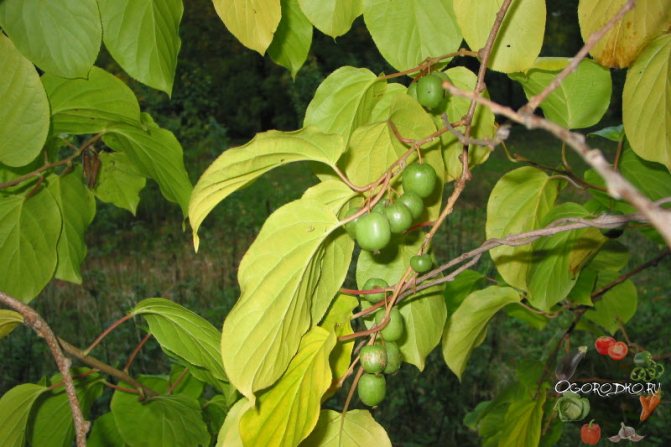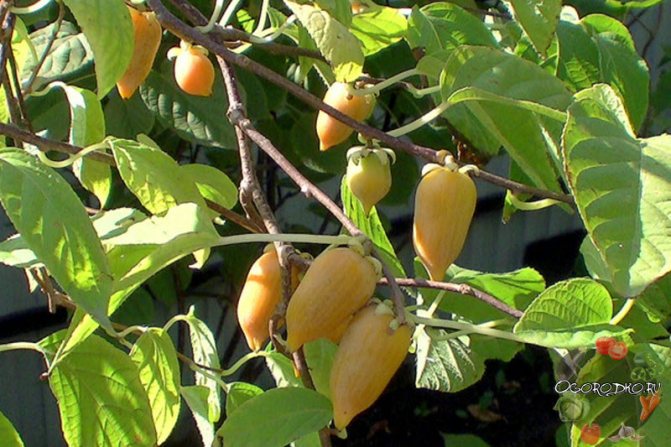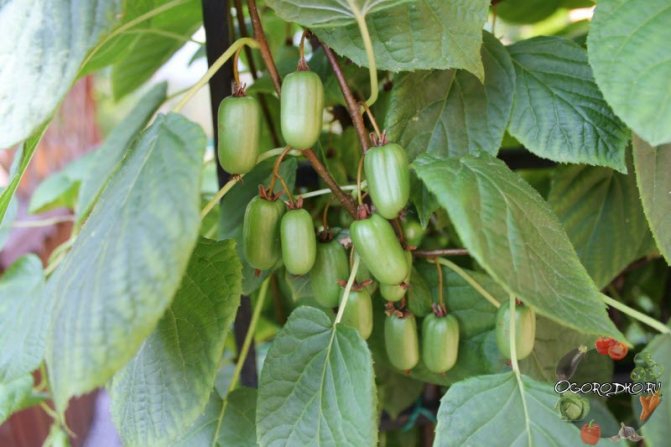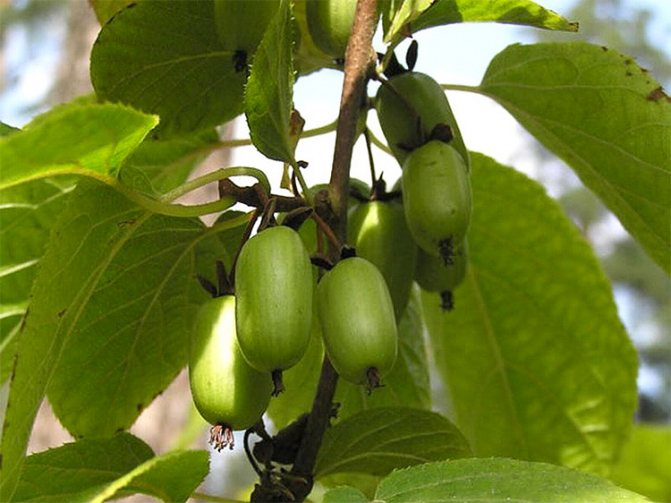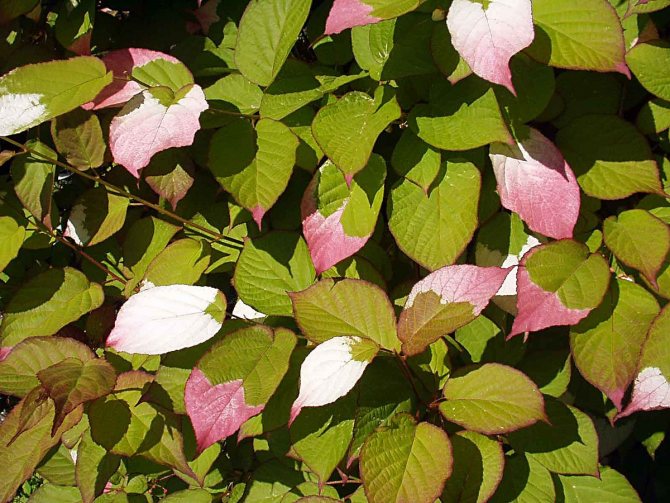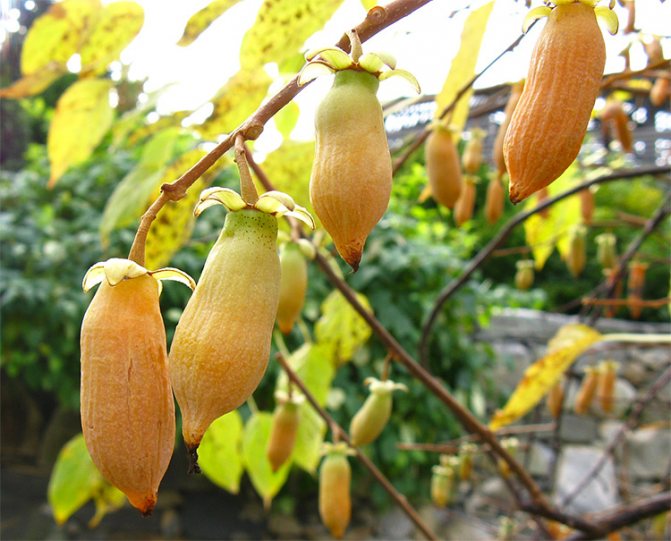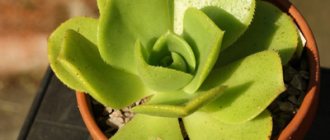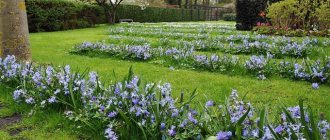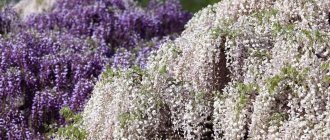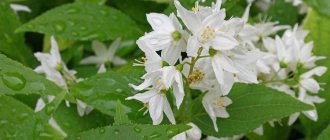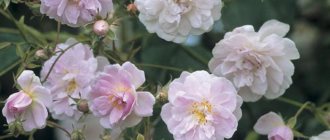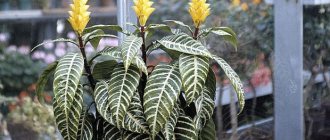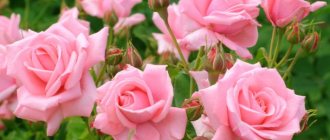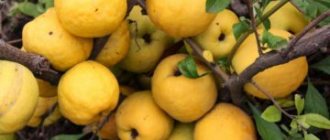Decorating a personal plot is a useful activity that helps you calm down after a hard day, put your thoughts in order and recharge yourself with positive emotions. What could be more beautiful than creating an attractive design around yourself. And when beauty and practical use are combined, the feeling of satisfaction from one's work knows no boundaries. Actinidia kolomikta in the Moscow region and in some other regions of Russia can be grown without additional shelter for the winter. This plant tolerates cold quite easily and does not suffer from insufficient heat in cool summers. It is used as an ornamental liana and a fruiting plant. The fruit is a berry with various flavors.
The article provides information on how the planting of vines and the subsequent proper care of it is carried out. You can also see the varieties of actinidia kolomikta in the photo and choose the one suitable for the site:
The best varieties of actinidia
Plants of the genus actinidia belong to the actinidia family and are deciduous liana-like trees, mainly growing in the mountain forests of the Himalayas and Southeast Asia. Actinidia is widespread in our country in the Far East. In nature, there are about 40 of its species, but we are well aware of Chinese actinidia or kiwi.
Actinidia is not yet a frequent visitor in our gardens, but it is gaining popularity, so I present to your attention the best varieties of actinidia with a brief description.
People's. Average level of winter hardiness and maturation. It is sufficiently resistant to damage by pests and diseases. Cylindrical berries weighing about 3 g, taste sweet and sour with a hint of strawberries. The content of vitamin C is 1850 mg per 100 g.
Waffle. As well as the People's average ripening period. Disease resistance at a high level. Average fruit weight 3.2 g, elongated oval shape. The berries are very tasty, juicy with delicate pulp and amazing aroma. Ascorbic acid contains 163 mg per 100 g.
Gourmet. Disease resistance is not bad, the ripening period is average. Fruits are larger than previous varieties - 4.4 g. Taste are good, have a pineapple flavor. Vitamin C contains in a proportion of 1700 mg per 100 g.
Queen of the garden. It differs from Gourmet by early ripening and lower weight of fruits - 3.4 g. The rest of the indicators are the same.
Hope. The variety has high winter hardiness and resistance to pests and diseases. The fruits are small (2.3 g), but the variety bears fruit abundantly. The content of ascorbic acid is 430 mg per 100 g.
VIR-54. Possesses the largest fruits - 5-6.5 g. Ripening later. A very promising variety.
The described varieties of actinidia were selected based on indicators from 70 varieties.
Types of actinidia
Such a well-known fruit as kiwi, sold in any vegetable outlet, is the fruit of Chinese actinidia - an extremely thermophilic culture that cannot germinate in our frost conditions. However, long-term gardeners are still trying to find a way to create conditions for its germination in our latitudes. The complexity of the rather time-consuming care of Chinese actinidia is to create a shelter. The other three varieties below are more cold tolerant.
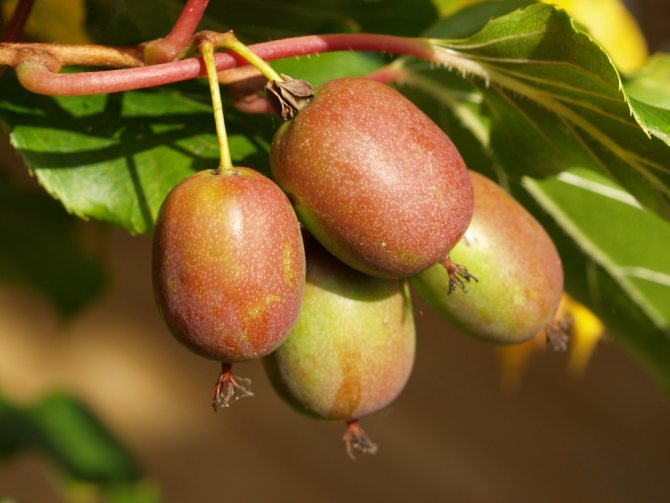
Actinidia berries
Kolomikta
It grows in its natural environment in the Far Eastern region. It has good resistance to frost, typical for the territory of the middle zone, which makes it possible to plant and care for actinidia in the Urals.
The temperature minimum, at which the development of actinidium in the Urals of Kolomikt is capable of continuing, is -44оС. However, spring temperature drops have a negative impact on the plant.
The maximum height of the shrub is 5 meters. The average trunk diameter of a fully formed plant is 5 centimeters. The color of the shoot is red-brown. Actinidia Kolomikta is distinguished by the appearance before the transition to the flowering stage of variegation of a whitish-crimson color. The flowers, which have an unusual lemon-lily of the valley aroma, are small in size. The flowering period begins at the end of spring. When ripe, the berries fall to the ground.


Fruiting shrub
Arguta
The height of the fruitful shrub of Argut actinidia can reach more than 10 meters. The index of frost resistance of this species is relative. Rare varietal varieties are capable of continuing their vital activity in conditions of a drop in temperature below -30 ° C. The average limit of cold hardiness of Argut actinidia is -27оС. On the territory of the Moscow region and central Russia, the temperature does not drop to this level every season, but once every 10 years such conditions occur in our country.
The leaf size of Arguta actinidia is larger than average. The diameter of the flowers without scent is 3 centimeters. The average quantitative indicator of productivity is 14 kilograms. Ripe fruits do not crumble.
Helpful information. The taste of Polygamy actinidia can be described as a mixture of figs with bell peppers.
Polygam
The height of the Polygama actinidia liana is 5 meters. This species appeared in the Far Eastern territory. The color of the shoots is light brown. Actinidia Poligama has a relative cold resistance - the minimum temperature at which the plant is able to continue fruiting is -31 ° C. However, shoots that have not completed the growing season are prone to freezing.
Note. The frozen shrub of Actinidia Polygamy independently restores its vital functions.
The color of the fruits of actinidia polygamy is yellow. The size of large leaves is 14 centimeters. The variegation, characteristic of the acquisition of silvery foliage, remains until the berries are fully ripe.
Important! To put the actinidia vine in the shelter, Polygamy must be removed from the trellis.


Berry appearance
In the list of the State Register of our country in the field of breeding achievements, more than 4 dozen varietal names of actinidia are presented, planting and care in the Moscow region can be carried out, as well as oriented towards cultivation in certain regions of Russia.
Often, the choice of actinidia is the best varieties for the Moscow region, the cultivation of which is limited exclusively to samples of planting material presented in nurseries. Since many seedlings are purchased abroad, most of them do not take root in our climatic conditions.
Which actinidia to choose
Actinidia is a rather rare culture in our country due to confusion with species. In total, there are 30 types of it, very different in properties. So, actinidia kolomikta can withstand 40-degree frosts, but does not grow at all in the South, where it dies from the heat. And many of its other species grow well in the southern regions, but freezes even in the Rostov region ... In order not to be mistaken with the purchase, one must clearly understand what actinidia is what it is.
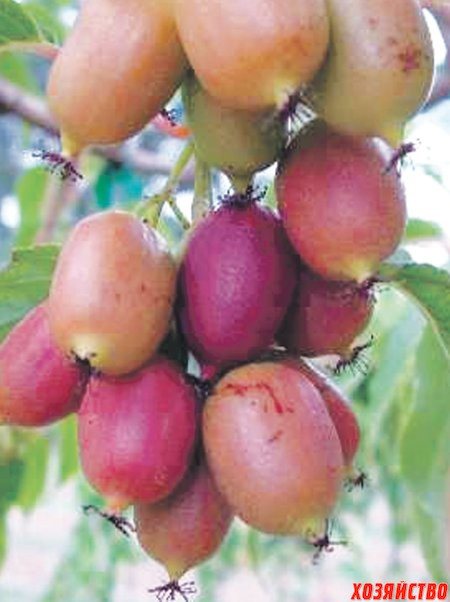

Actinidia Chinese – or kiwi... “Growing” is only on the shelves. Its vine does not withstand winter frosts, even in a buried state. Suffers from droughts and dry winds. In general, we will not be able to grow it.And it does not matter - this is one of the few varieties, the fruits of which must be peeled.
Actinidia kolomikta, or gooseberry - in nature, the length of its vines reaches 8-10 m. In culture - 3-7 m. Afraid of air drought and heat. But it has the highest frost resistance. Suitable only for the Middle Lane. The fruits of kolomikta are soft, oblong, 2-3 cm long, and vaguely resemble gooseberries (hence the second name of the plant). Their color is green with a yellowish tinge. Taste the fruits with caution. Unripe (and sometimes mature), they can cause severe soreness and burning lips.
Actinidia polygamous, or polygamous - less hardy than kolomikta, but also does not tolerate heat and drought. It is mainly used for decorative purposes. The flowers are large (2.5 cm in diameter), white or yellowish, with a strong pleasant aroma. Young leaves are silvery white. Blooms in July. Fruits are cylindrical, 2–4 cm long, light orange, with a “spout”. Varieties - Yellow Spindle, Pepper, Canary, Solntselikaya.
Fresh fruits are inedible - the sweetness of the pulp is combined with a sharp pungency and peppery aroma. The pungency and pungency disappear only after freezing.
Acute actinidia or arguta - a promising fruit crop. 30-50 kg of berries are harvested from one bush. In some varieties, berries reach 45-70 g in weight! But it is less winter-hardy, grown in the South - and it is desirable to shelter for the winter with land. Requires frequent watering. An important advantage is that large fruits are tasty, of various beautiful colors (from green to golden, red-dark brown, etc.).
Arguta varieties are actively developed in Ukraine. There are already a dozen varieties, of which 3-4 are of great interest to gardeners.
Actinidia purpurea - during the ripening of the fruits, it is especially decorative: it seems that red candies are hung among the green foliage. Moreover, these "sweets" are very sweet and healthy. 10-12 kg of berries are collected from one bush. Liana grows both in the South and in the Moscow region. But there are two "selection centers" - in Kiev and in the Moscow region. Kiev varieties freeze out in the Middle Lane, Moscow varieties do not tolerate the southern heat.
Basically, it is crossed with argut - the hybrids have higher winter hardiness (the donor is purple) and a branched stalk, which triples the yield (from argut). The most famous of these hybrids: Kiev hybrid, Kiev large-fruited.
yard.
Planting actinidia seedlings


If you decide to plant actinidia on your site, then you need to use sprouts obtained by cuttings (actinidia grown from seeds lose their varietal characteristics)
... You can grow seedlings yourself, or you can buy them in a specialized store. When buying actinidia seedlings, two circumstances should be considered:
- How was the escape obtained (if the shoot grows from a bud - it is obtained from seeds, if a short trunk with lateral shoots - the shoot is obtained by reproduction from a cutting
). - What gender is the plant (actinidia are dioecious crops, therefore, for fruiting, it is necessary to buy seedlings of both sexes
).
Important! When purchasing actinidia seedlings, you should pay attention to the roots - they must be covered (in the ground, polyethylene, a special container). Sunlight, heat, dry air can harm the plant. The most optimal age of the seedling is no more than three years (more "adult" plants tolerate transplanting worse). The gender of a plant can only be recognized by its flowers. Cutting seedlings inherit the sex of the donor plant, therefore it is recommended to buy the shoots of faded plants.
Optimal planting times
The cultivation of actinidia is largely dependent on the time of planting. There is no consensus among gardeners about the optimal timing. Several options are possible:
- early spring, until the juices began to move;
- late April - early summer (after the end of flowering);
- autumn (at least two to three weeks before the start of frost).
Soil composition
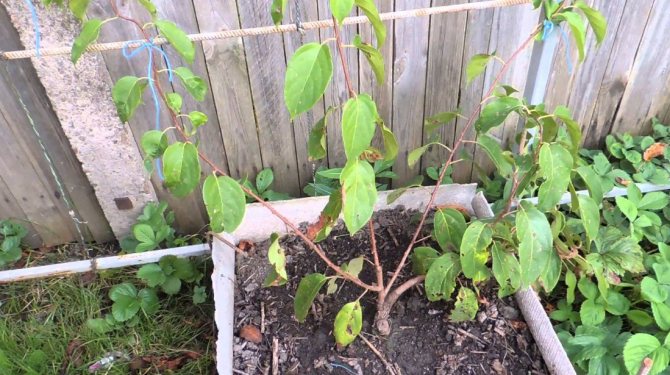

Actinidia prefer acidic and slightly acidic soils (pH = 4 - 5), but grow well on neutral (with good fertilization).
Clay soils with a high level of groundwater are least suitable. A prerequisite for successful growth is that the soil for actinidia must have good drainage. It is advisable to plant plants in elevated areas with natural runoff.
When planting actinidia in advance (two weeks), you need to prepare the landing pits (when decorating walls - trenches):
- 0.5 m - width, length, depth (the length of the trench depends on the length of the wall);
- drainage (brick chips, pebbles);
- on top of the drainage - enriched soil (humus (bucket), charcoal (50 gr.), superphosphate (250 gr.).
After settling the soil, during planting of seedlings and after, you should fill up with ordinary soil.
Good predecessors and neighbors of actinidia
The best predecessor is black currant (it loosens the soil, does not drain it). The choice of "neighbors" is due to the usefulness of the plant for actinidia. The beneficial effect is provided by:
- legumes - beans, beans, peas (improve the soil, maintain the desired moisture balance, improve the microclimate);
- black currant, hazel;
- flowers - petunia, gerbera, calendula, aster, etc. (do not dry out the soil, decorate).
Negative consequences are guaranteed when landing next to:
- mature fruit trees (especially apple trees). Trees dry up the soil with their roots. Digging up the periosteal circle is dangerous for the roots of actinidia. The described plant can climb tens of meters up and braid trees, which makes it difficult to collect fruits;
- young fruit trees (can die from the "embrace" of the vine).


Important! Actinidia must be shaded until they reach 3 years of age (the sun's rays can cause burns to the root system and stems).
Correct fit
Before planting, actinidia seedlings are prepared as follows: dry or broken shoots are cut off, the roots are dipped in a clay mash, a bucket of water is poured into the pit.
The root collar should be flush with the ground. It is necessary to ensure that voids do not form, trample the earth a little and mulch with organic matter.
For fruiting, there should be one male for every three female plants.
The distance between seedlings when planting is at least one and a half meters. Upon completion of planting, it is necessary to water the seedling with 2 - 3 buckets of water and close it from direct sunlight with gauze, paper, etc.
Did you know? It is possible to determine where are females and where are males only by the flowers of actinidia: if in the middle of the flower there is a white ovary with stigma-rays, this is a female flower, if the ovary is surrounded by stamens, it is a male.
Characteristic features of actinidia kolomikta


Thanks to the efforts of breeders, such an outlandish plant as actinidia kolomikta is successfully grown and bears fruit even in the regions of the Russian Federation. This species is frost-hardy, tolerant of the harsh conditions of our climatic zone and is quite unpretentious to care for.
Outwardly, actinidia kolomikta resembles a liana with weaving branches and large heart-shaped leaves. The color scheme of the foliage is inconsistent and changes depending on the season. The flowering of actinidia begins in mid-May and can last for several weeks, the flowers are irregular in shape, have a pleasant fragrant aroma. The plant bears fruit since August, but often this phase is delayed until October.
The fruits of actinidia contain a whole range of vitamins and nutrients:
- vitamins C, P, group B;
- citric, malic, oxalic acids;
- glucose;
- polyphenols;
- biologically active substances.
Actinidia kolomikta holds the record for vitamin C content, leaving far behind lemon and black currant.
As preparations for the winter, many housewives grind fruits with sugar or dry them.However, when consumed, one should take into account the fact that the berries have a strong laxative effect, and dose their use.
Actinidia kolomikta belongs to dioecious plants, there are male and female types. When planting in a garden, it is necessary to place male and female plants side by side so that the crop yield is full. Propagated by cuttings, which are best planted in the ground in spring.
How to distinguish a male actinidia plant from a female?
Most species of actinidia are dioecious representatives of the flora. For pollination of 5-7 female plants, one male is enough, but for a safety net it is better to plant 2. The first harvests of vines begin to give in 4-5 years, and not conscientious sellers can slip not the plant that is needed, but what is on sale. In order not to have to be disappointed after so much time, it is important to immediately determine the sex of the bush.
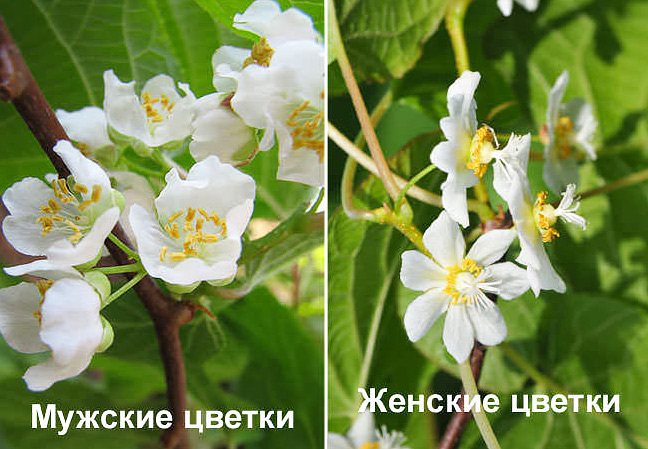

Flowers for men and women
Botanists can do this by examining the buds, but a simple summer resident cannot do this, so they will have to wait for flowering. Male flowers reach 15 mm in diameter, female flowers are slightly larger, about 20 mm. But this is not the main difference. Female flowers have a pistil in the middle, which sets fruit after pollination; inside male flowers there are only stamens that spread pollen.
Attention!
You cannot buy other actinidia as a pollinator! Female colomicts are pollinated by male colomicts, female arguta is pollinated by male arguta, and polygamous actinidia are also pollinated only among themselves.
The best varieties of actinidia kolomikta for the Moscow region
The climatic conditions of the Moscow region are rather harsh. There are frosts in the spring-winter period and dry summer days. The optimal area for the cultivation of actinidia kolomikt is the southern regions, but with the help of the efforts of breeders, some varieties of tropical plants are suitable for growing in the Moscow region, the presented photos of each of them will help gardeners to determine belonging to a particular variety.
The most recommended varieties of actinidia kolomikta for growing in the Moscow region:
- Doctor Shimanovsky;
- Adam;
- September;
- Vitacola;
- Gourmet.
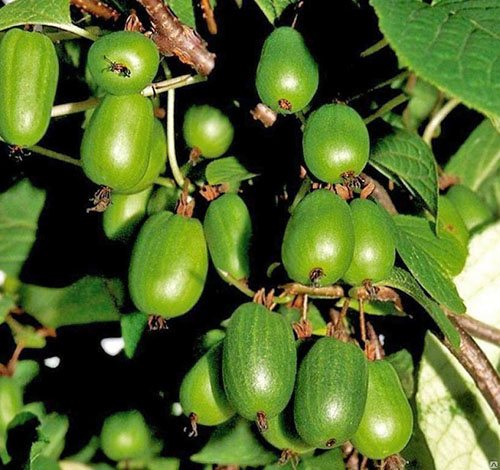

Actinidia kolomikta Dr. Shimanovsky is a type of plant with small oval-shaped berries that ripen in August. It is advisable to plant this variety in a sunny place, but not in direct scorching rays, the presence of a light shade is required. The berries have a pronounced apple and pineapple aroma.


Actinidia kolomikta Adam is an ornamental variety with unusually colored foliage that blooms in green, turns white by the end of spring, and acquires a pink color by autumn, the color saturation is constantly increasing. This variety loves sunny, low wind places, is perfect for decoration purposes when creating hedges, gazebos, arches, landscaping balconies and loggias. Adam is a male type of actinidia colomicta. During flowering, it becomes covered with small white inflorescences, exuding a pleasant aroma, similar to the scent of lemon. The variety grows very quickly, reaching a height of four meters.
How to propagate actinidia
There are several ways to propagate actinidia: cuttings, layering and seeds. The latter method is used the least frequently. This is due to the fact that in half of the cases, male plants grow from germinated seeds.
Moreover, it is impossible to predict in advance what actinidia will be. Only specimens aged 5–7 years enter the fruiting phase. Therefore, if you do not know if the plant is male, then you can find yourself in a rather unpleasant situation.
Reproduction by layering... In order to avoid possible difficulties during reproduction, it is recommended to use layering.The first step is to select a healthy, well-developed vine, which needs to be dug in in May or early June.
In the fall, it turns into a fairly high-quality seedling with a powerful root system. but experts recommend leave them until early spring, so that at this time you can prune the vine without causing serious injury to the plant.
Features of care for actinidia kolomikta
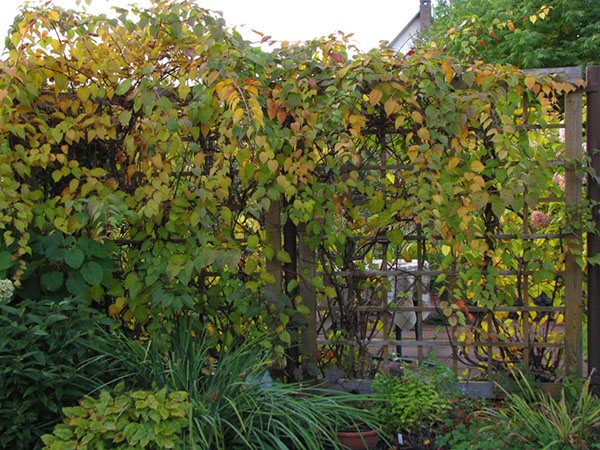

A distinctive feature of the actinidia kolomikt is its frost resistance, but to ensure safe wintering, it is necessary to additionally cover the plant in late autumn. Given the culture's love of branching, it should be provided with additional supports.
It is preferable to choose soil with an admixture of clay or sand so that it is loose and quickly moistened. It is recommended to plant actinidia in early May; keep a distance of at least two meters between the plants. The upper layers of the soil should be enriched with humus or rotted organic fertilizers. For good fertility, the crop should be regularly fed with nitrogen-containing compounds.
It is necessary to organize watering of actinidia kolomikt by airborne droplets in the evening, on hot days it is imperative to additionally moisten the soil around the plant. Loosening is carried out often, followed by mulching of the near-stem area.
Actinidia rhizomes are well developed and located shallow underground. This fact should be taken into account when loosening the soil, so as not to damage the roots.
Considering all the above recommendations, each gardener can grow actinidia kolomikta on his site by choosing one of the recommended varieties for the Moscow region from the photo.
Interesting about actinidia kolomikta - video
glav-
The right time to disembark
Honeysuckle: planting and care in the suburbs
Note. Actinidia is planted in the spring, but it is permissible to carry out planting work in the fall, 2 weeks before the cold snap.
Important! The slightest deformation of the root system should be avoided, since the plant is not always able to endure even a 10-minute exposure to air with open roots.
The best option would be to transplant a mature seedling from a container. The age of the planting material should not exceed 3 years.
Note. It is not recommended to plant the plant in hot weather.
When planting, a distance of approximately 3 meters should be observed.
The germination of the root system of the actinidia creeper is carried out in the horizontal direction. The shallow planting pit must be well drained to avoid fluid stagnation. For the manufacture of drainage, you can use the following materials:
- brick debris;
- pebbles;
- coal slag.
Step-by-step instructions for planting work:
- 2 weeks before disembarkation, create a 50 cm depression with a diameter of 44 cm;
- Set aside the topsoil;
- Lay drainage with a 10 cm layer;
- Mix the top layer with a bucket of humus;
- Fill the pit with a bucket of water;
- Wait for the soil to settle;
- Water the seedling in a container;
- Remove the seedling, avoiding deformation of the root system;
- Fill a small hill from clean soil;
- Install a seedling;
- Cover with planting mixture;
- Water the plant;
- Mulch the ground;
- Protect the plant from pets;
- Create shadow conditions for 2 weeks.
Note! It is unacceptable to introduce fresh mullein and lime into the planting pits.
Variety selection rules
Actinidia is native to Southeast Asia, so the vine is demanding for light and warmth. Nevertheless, there are varieties that are well adapted to the rather difficult soil and climatic conditions of the Moscow region. Most popular, the best varieties and varieties of Actinidia have combined good resistance to low temperatures and unpretentiousness.
Southern subtropical plants need less food area than other berry bushes most common in home gardening, and even more fruit trees, which makes them relevant for small garden plots. When choosing a variety, preference should be given to zoned varieties adapted to the weather conditions of the Moscow region, care for which is not difficult even for beginners and inexperienced gardeners.
Growing methods in the Moscow region
Actinidia is a type of vine, experts recommend using a trellis for its cultivation, the length of which should be at least 2 meters. There are 4 rows of wire on it, which run every 40-50 cm. These rows will be needed to weave the stem, and also allow you to form a beautiful crown.


Actinidia requires careful maintenance and periodic pruning. This process begins already in the first year of life, after which it should be repeated every autumn. By pruning, the grower can remove the weakest shoots and thus make the shrub stronger and stronger.
Actinidia: planting and care (video)
It should be remembered that the Argut variety is less frost-resistant than the Kolomikta species, and requires the branches to be sheltered for the winter. It is Arguta that is the most productive species of the genus actinidia, and the yield of each adult plant can reach 45-50 kg of ripe berries. Therefore, planting even one plant can provide a whole family with berries. For the cool climate near Moscow, not only actinidia kolomikta is well suited, but also actinidia acute, which has sufficient endurance.
Actinidia is a berry of the future from the past
Another well-known breeder I.V. Michurin, who popularized and introduced actinidia into agriculture, believed that this is the plant of the future. He was sure that the unpretentious liana would take one of the first places among the berry crops in Russia, displacing grapes, as it surpasses it in quality and useful properties of the fruit. The prophecy of the legendary scientist begins to come true. Today, most of the owners of country houses are trying to purchase seedlings of a medicinal plant. Actinidia began to be cultivated in Western Europe, Ukraine, Moldova, India, and the area of distribution of this amazing vine is becoming wider every year.
The best varieties for the Moscow region Argut and Kolomikt
The largest number of positive reviews from Moscow Region gardeners is received by the Kolomikta variety. Such varieties take root well from the north and northwest sides of buildings and annually form several kilograms of delicious berries. Active fruiting can last 40 years or more.
| Variety name | Description of fruits | Ripening period | Advantages of the variety |
| "Waffle" | Cylindrical, 2.5-3.5 cm, 2.55-3.55 g, smooth, with a translucent and thin skin, olive green, sweet and sour, aromatic | Mid august | High productivity and early maturity. |
| "Grape" | Oval, 2.1-2.3 cm, 2-2.25 g, with a translucent and thin skin, olive green with light stripes, sour-sweet, with an apple flavor | First days of August | High productivity, early ripening of the crop |
| "Far East" | Cylindrical, slightly compressed from the sides, 2.2-2.4 cm, up to 2.25 g, dark olive, smooth, thin-skinned, sweet, with strawberry aroma | First days of August | Early ripening, high content of ascorbic acid, good productivity |
| "Abundant" | Cylindrical, slightly compressed from the sides, 2.55-2.75 cm, up to 3-3.65 g, smooth or ribbed, yellowish-green with light stripes, sour-sweet, with a pineapple aroma | First days of August | Early maturation, good productivity |
| "Graceful" | Cylindrical, up to 2.65-2.85 cm, up to 4.25 g, smooth or finely ribbed, olive green with blush, sweet and sour, with pineapple aroma | Mid august | Increased amount of ascorbic acid, good productivity, large-fruited and decorative |
| "Gourmet" | Cylindrical, laterally compressed, 3.1-3.2 cm, up to 5.25 g, olive green with light stripes, thin-skinned, smooth, sweet and sour, with pineapple aroma | Mid august | Increased amount of ascorbic acid, good productivity, large fruit |
| "Coin" | Oval-elongated, up to 2.5 cm, up to 3.55-3.75 g, olive green, smooth or finely ribbed, sweet and sour, with a pronounced pineapple aroma | First days of August | Early maturing and productive variety |
Video: everything about actinidia - when to plant, the pros and cons, gardener's advice
Tags:
Share on social networks:
It will be interesting for you to read:
- Features of growing cacti in a pot, at home. Cactus care and replanting. Reproduction of cacti by children and seeds. Varieties of cacti.
How to properly grow tomatoes on the balcony: which varieties are better to choose. How to care for seedlings and prepare the soil for planting tomatoes
The best varieties of raspberries, description of varieties: red, yellow, black, remontant raspberries. How to plant raspberries correctly
The best varieties of gooseberries with a description. How to grow gooseberries correctly. The recipe for royal gooseberry jam and the beneficial properties of the berry
Planting rules for actinidia
Currently, planting actinidia involves the observance of several very important rules:
- the standard distance from the fence or structure to the landing pit should not be less than 0.7-0.8 m;
- planting of actinidia kolomikt should be done in early spring, since autumn planting is most often complicated by the freezing of immature plants;
- in order for the root system to receive a full-fledged formation, it is necessary to provide the vines with high-quality and competent care in the first two months;
- the average distance between planted berry vines should not be less than one and a half meters;
- the standard depth of the planting hole should be 0.5-0.7 m with a drainage layer at the bottom of 0.40-0.45 m.
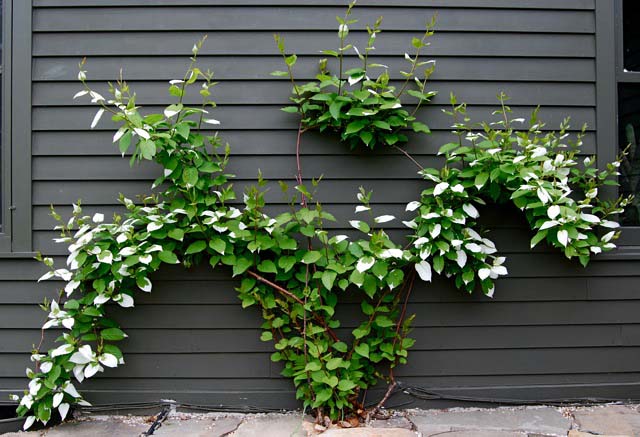

Immediately before preparing the planting holes, you should dig up the area as carefully as possible and remove all weeds. Drainage is laid in the planting pits on the basis of brick battle or river pebbles, and then 20-25 cm of fertile soil is poured with the addition of mineral fertilizers.
For each seedling, it is recommended to spend 1 bucket of organic compost with the addition of 180-200 g of superphosphate, 20 g of calcium chloride, 500 ml of wood ash and 50 g of nitrogen-containing fertilizers. When digging into clay soil, it is necessary to add about 1 bucket per square meter of sand screening.
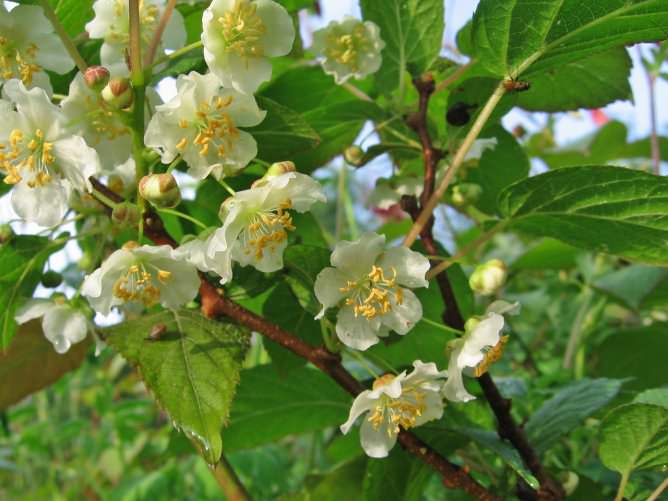

Reproduction of actinidia
Actinidia reproduces quite simply. Vegetative reproduction has advantages - it conveys the characteristics of the variety, sex, fruiting in the 3rd - 4th year. Seed reproduction makes it possible to get more hardy plants, but fruiting - from the age of 7.
Root offspring
Reproduction by root suckers is used for actinidia polygamy and kolomikta.
Did you know? Reproduction by root suckers in arguta is impossible - this variety does not have root suckers.
Green and lignified cuttings
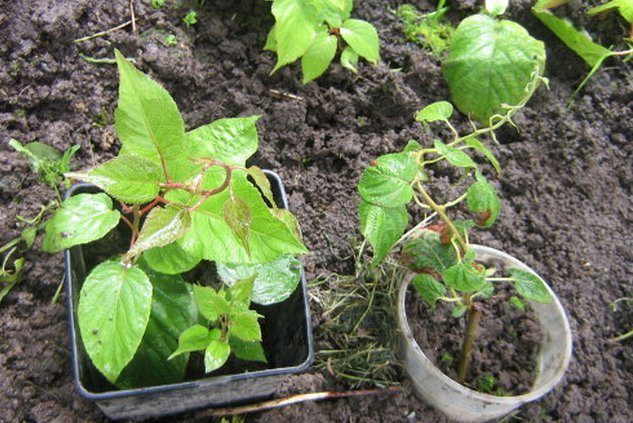

Description of the methods of vegetative propagation of actinidia, one must start with the fastest and most common - cuttings. This method allows you to inherit varietal traits and get a lot of seedlings. Two options are used - green and lignified cuttings.
Green cuttings (the upper part of the shoot is from 10 to 15 cm) are stored in late May - early June (when flowering ends): a cutting with two to three buds and internodes. The lower cut of the cutting should be 45 °, the upper cut straight. Shank:
- planted for rooting in a planting pit with a substrate (drainage, 10 cm of a mixture of humus with sand and 5 cm of river sand), kept under a film, sprayed twice a day;
- after 30 days they begin to air, from August they open for the night;
- for the winter they cover with a pillow of leaves, in the spring they are transplanted.
Lignified cuttings (length - 20 cm) are harvested in the fall and kept in bunches in the sand until spring (in an upright position), after which they are planted in a greenhouse.
The rooting rate of such cuttings is lower than that of green ones.
To increase this indicator, the kilchev method is used (a month before planting, the cuttings are placed on ice with the upper ends and closed - the development of the buds stops. The lower parts are warm. After 30 days, roots appear, then the cuttings are planted in open ground).
Division of bushes
The division of bushes is not often used in household plots as a method of propagation of actinidia, but if there is a bushy plant on the site (it grows on poor soils, suffered from frost, without support, etc.). The bush is divided after leaf fall before frost or in early spring before the juices begin to move. Each part of the divided bush must carry stems and roots at the same time.
Reproduction by branches
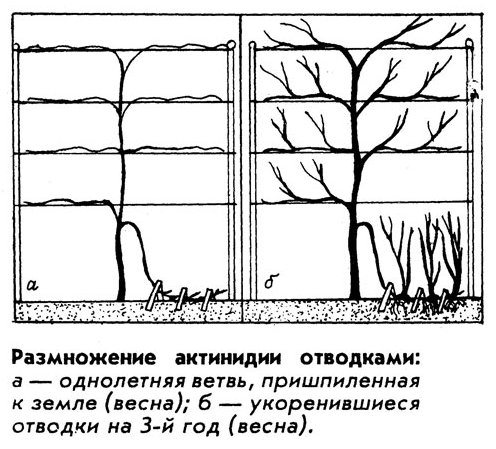

The method of propagation by layering is simple and effective. Grooves are dug under the liana (7-10 cm deep), the soil in the grooves is mulched with humus, peat, sawdust.
Care for actinidia during reproduction by branches in the spring includes laying the lower young shoots in the grooves, fixing them, filling them with soil and regular watering. The tip of the shoot remains above the ground. Layers are separated for the next year.
Care features
Proper care of a perennial woody deciduous vine from the Actinidia ceae Hutch family includes the following activities:
- immediately after planting, watering is carried out at the rate of 5-7 liters per bush;
- further irrigation measures involve moistening the soil to the depth of the root system;
- a good result is given by morning or evening sprinkling from a hose with a water jet diffuser;
- for the purpose of feeding plants, spring and autumn application of mineral fertilizers is used;
- in the spring, fertilizers are used in the form of ammonium nitrate, double superphosphate and potassium salt;
- in the fall, in mid-September, top dressing should be applied in the form of superphosphate and potassium salt, without the addition of chlorine.
- vines need the installation of supporting structures, which can be represented by trellises or frames.
- supporting structures should be oriented in the direction from east to west, provided that the plant is planted from the south;
- pruning is carried out in the autumn period, immediately after active leaf fall and involves the formation of a plant in the form of a fan or ridge.
A short description of the creeper and her photo
Actinidia kolomikta is a powerful liana, which lignifies during growth and tightly braids the supporting structure counterclockwise. A brief description will not convey all the beauty of this plant, so we suggest looking at its photos, presented on the page in large numbers.
The trunk of the creeper is absolutely smooth to the touch, it is covered with a dense bark of a rich brown shade. The trunk height is 5-6 meters. Powerful lateral shoots develop on the main trunk, they can be:
- vegetative type (used for propagation and propagation);
- fruit branches (buds are formed on them and subsequently fruits);
- mixed type, bearing the function of cuttings and fruiting.
Dormant buds on the trunk are almost invisible, since they are completely drowned in the bark. They are located a few millimeters above the leaf stem. The sheet deserves special attention. It has an oval, slightly pointed shape, the edge of the plate is serrated. Coloring - from bright green to spotty variegation. The length of the plate is 12-15 cm, with a width of up to 8 cm. The arrangement of the foliage is alternate, rather dense.At the end of September it changes color to yellow and purple tones.
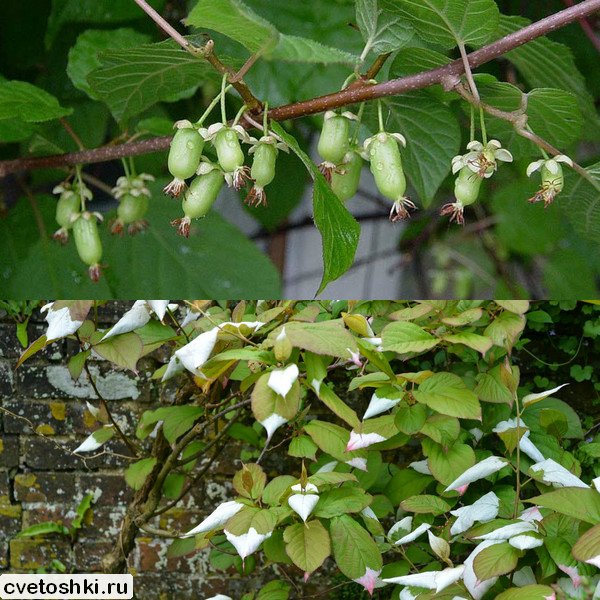

Liana grows rapidly with sufficient nutrients. On average, over the summer months it can give an increase of up to 1.5 meters. The depth of the root branched system is 25 cm, therefore, regular loosening of the upper soil layer is required to ensure the flow of oxygen. On heavy loamy soils, the root system dies off and the plant dies.
The flowering period occurs at the end of May - mid-June, depending on the timing of the onset of stable above-zero temperatures in the spring. The structure of the bud is simple, consists of 5-9 simple oval petals. Decorative terry in this plant is very rare. During the flowering period, actinidia kolomikta exudes an amazing aroma for several meters around it, reminiscent of a mixture of bird cherry and lemon notes. Approximately 70% of the buds subsequently yield edible fruits in the form of berries. In appearance, it resembles a small kiwi fruit. But before the first harvest, at least 3 years must pass from the moment of planting.
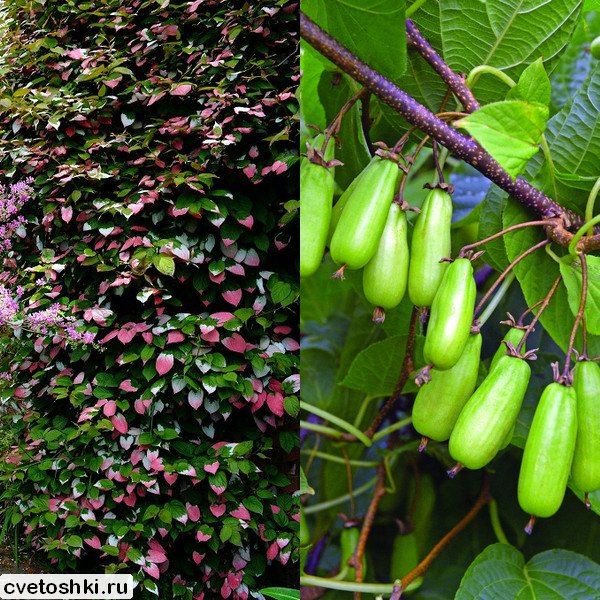

Description of actinidia varieties.
Actinidia variety - Actinidia kolomikta.
Actinidia kolomikta -A. Kolomikta Max. The simple name is maksimovnik, taiga pineapple, creeper, raisins, Amur gooseberry. Branching bush liana 6-8 m tall, with a small branch trunk diameter. Young shoots are curly, the bark of the trunk is brown with yellowish lenticels. Cold-resistant type of actinidia.
Description. The leaves are round-ovate, with a linear apex, sharp edges and pubescence along the veins. Flowers are white, dioecious or monoecious, single and paired.
There are many stamens, the berries are bluntly ellipse up to 2 cm long and 1 -1.5 cm wide, green, juicy, sweet, with numerous small seeds. Fruits contain 4.5-8.3% sugar, total acidity - 0.78%; 930 mg% vitamin C. The weight of the fruit is about 4 g. The yield per bush is 2 kg; in natural conditions, 5-8 kg of fruits are harvested from the vines.
The fruits of actinidia kolomikta ripen at the same time and crumble. In the wild in the USSR, it is distributed in cedar-broad-leaved and mountain pine-fir forests in the Primorsky Territory, along the entire Amur, Ussuri line, in the regions of Sakhalin, on the Kuril Islands.
Actinidia varieties - Acute Actinidia.
Acute actinidia - A. arguta (Zieb. Et Zucc) Planch. The local name is kishmish. A woody, large creeping vine up to 8-10 m tall. Young shoots with numerous lenticels, the bark of the trunk is gray.
Leaves are dense, egg-like, with a triangular tip, glossy above, with thin teeth along the edges. Flowers are dioecious, sometimes monoecious, polygamous. Berries of various shapes - from round-like to cylindrical, green, juicy, with numerous small seeds, do not crumble when ripe. Fruit weight - 8-10 g, yield per vine - 5-10 kg.
In the wild, it is found in the coniferous-deciduous forests of the Primorsky Territory, on Sakhalin, the Kuril Islands. This species is the most prolific, but less hardy.
Actinidia varieties - Actinidia polygamous.
Actinidia polygamous (tridomna) -A. polygama (Ziel et Zucc). Max. Local name - pepper, pepper, raisins. Thin-stemmed creeping vine up to 5-6 m tall, reddish bark. Leaves are egg-shaped with a slightly narrowed tip. Flowers are tridomous, single or triple in the scutellum. The berries are lemon-shaped, orange in color, bitter, bitter in taste.
Actinidia varieties - Actinidia purple.
Actinidia purpurea -A. Purpurea Rehd. The species is close to actinidia argut. Large woody liana 8-10 m tall. Young growing shoots curl well, pink in color. Leaves are elliptical-oblong, 8-10 cm long, green, smooth or pubescent along the main vein of the leaf. Petioles 3-5 cm long. Flowers are dioecious, female - single and double; male, 3 per inflorescence.
Blooms in late May - early June. The berries are cylindrical, elongated, 2-2.5 cm long, purple color, sweet-sour taste, juicy, with numerous small seeds, weight - 10-12 g, do not crumble. Productivity is 10-12 kg of a bush. Grows wild in China in the provinces of Sichuan Eastern Yunnan, Fujian, Jiangsu.
Actinidia varieties - Actinidia Chinese.
Actinidia Chinese -A. Chinensis Planch. Liana 8-10 m tall; young liana-like shoots curl well, well pubescent.Leaves are large, large, 7-15 cm long, 5-15 cm wide, wide, pubescent. The flowers are dioecious, large, yellow-orange, with a large number of stamens.
Fruits are semicircular, 3 cm in diameter, fruit weight - 30 - 40 g, very pubescent, fragrant, juicy, good in taste. They are rich in vitamins and mineral salts. The content of sugars is 9-10%, acids -1.3, protein-1.6%, there are vitamins C, E, carotenoids. The fruits contain iron, manganese, phosphorus, as well as a special enzyme - actinidin.
The most valuable subtropical species of actinidia. Not hardy. It grows wild in Eastern and Central China, the local name is Yangtao. In the forest-steppe, actinidia plants freeze slightly and must be covered for the winter.
Actinidia Chinese is grown on grape-type trellises, feeding area - 4 X 4; 5 X 5; 4.3 X 4.3; 4 X 5 m. The yield of one plant reaches 40-50 kg.
Propagated by seeds, budding, cuttings and jigging. When planting, the ratio of male and female plants should be 1: 6. In special storage facilities, in the presence of 3% carbon dioxide, 3% oxygen and 94% nitrogen, actinidia fruits are stored for 5 months.
In recent years, Chinese botanists and breeders have paid special attention to actinidia as the most large-fruited species. For the first time in New Zealand, breeding work was carried out to create large-fruited varieties. There are 5 such varieties bred here: Abbot, Allison, Bruno, Hayward, Monty, which are named Kiwi after the name of the kiwi bird - the main symbol on the coat of arms of the country of New Zealand.
The country has created an industrial crop of varieties of actinidia Kiwi - more than 1000 hectares, the gross harvest of fruits is 4-5 thousand tons per year, which are mainly exported.
Actinidia varieties - Kiev hybrid (No. 1-10).
Kiev hybrid (No. 1-10) - A. argutaX A. purpurea. The elite seedling was selected in 1977. The mother plant is a ligneous large liana. Shoots are gray with numerous white dots. Winter hardy variety. The leaves are large, oval-elliptical, smooth. Flowers are dioecious, white, single or 2-3 in inflorescences. Blooms in early June. 16.06%, Acid 1.05%, Vitamin C 132.96% mg per crude. Productivity is 8-10 kg per bush.
Berries are used fresh and canned. The berries are broadly egg-like, green with brown spots, large, 34 X 25 mm in size, weighing 10-12 g. Ripen in early September. The pulp is tender, sweet, reddish around the seeds and at the base of the stalk. The seeds are small and brown.
Actinidia varieties - Pineapple Michurina.
Pineapple Michurina. The variety is bred from seedlings of the third generation of actinidia kolomikta. Liana is brown in color with young brown shoots. The leaves are green, then turn dull white, and in the fall - pink, which provides decorative plants. Fruits are broadly oval, oblong, dark green, with a weight of 4 g.
Ripen in mid-August. The pulp is light green, juicy, sweet, with a delicate aroma that resembles pineapple. In actinidia kolomikta, the fruits ripen at the same time and easily crumble. In the conditions of the forest-steppe, the Pineapple Michurina variety grows well and bears fruit, it can be used in breeding.
Actinidia varieties - Clara Zetkin.
Clara Zetkin. The variety was bred from seedlings of the fourth generation of actinidia kolomikta. Liana reaches up to 3 m in height. Fruits are long, cylindrical, elliptical, light green, weighing 3-4 g. Ripen in mid-August. The pulp is pale green, juicy, very sweet, with a strong specific aroma.
At the Pavlovsk Experimental Station VNDIR (Leningrad Region), since 1949, work has been carried out to breed high-winter-hardy productive forms of actinidia. From the sowing of seeds of actinidia kolomikt, obtained from the Primorsky Territory, promising forms were derived, which are proposed for home gardens in the north-western regions.
Formation and pruning of actinidia
The formation of a bush is a necessary procedure that avoids the "thickening" of the crown and rejuvenates the plant. Pruning is carried out only in autumn, in October and November, since actinidia have very active sap flow in spring. The plant can lose too much liquid and die.
- In the first year after planting, the top of the vine is shortened to enhance the growth of lateral shoots.
- In the second year, the bush is pruned at a height of 50 cm, leaving 2 strong stems and tying them on the trellis from different sides.
- In the third year, 4-6 large shoots are left on each of the skeletal branches, growing outward, the rest are removed.


Arch-shaped actinidia
With sanitary pruning of actinidia, weak, damaged and diseased branches are removed. At the age of 7-10, rejuvenating pruning is carried out by cutting out old branches. In the case when the branches coming from the main trunk are removed, they are cut off completely, without leaving "hemp" and this place is immediately covered with garden pitch.
Types and varieties of actinidia kolomikt, argut, polygamy


Fragrant. A variety of actinidia for universal use, almost does not crumble. Fruits are large, cylindrical, yellow-green in color, slightly ribbed. Weight about 3 g. Sour-sweet taste with nutmeg aroma. Early ripening. Tasty fresh, good for making juices, compotes, preserves and even aromatic healing wine. Breeding F.K. Teterev.
For the Central region (including the Moscow region)
• Early ripening varieties (ripening in early August): Grape, Queen of the Garden, Monetka (mid-early), Stranger, Precious (earliest variety), Festive Household, Early Dawn, Fantasy Gardens. • Mid-season varieties (mid-August): Wafer, Izobilnaya, Lakomka, Narodnaya, Soroka, Universitetskaya, Marmeladka, Slastena. • Late ripening (late August - early September): Moskvichka, Moma.
Harvesting and storage
Actinidia bears its first fruits at the age of three to four years.
Plants seven years of age and older bear fruit regularly (one actinidia can yield from 12 to 60 kg of yield). Harvesting begins at the end of August and continues until frost.
The ripening period of berries of different varieties of actinidia is not the same:
- kolomikta - in mid-August (fruits ripen unevenly and some of them may crumble to the ground). Green fruits can ripen in the warmth after being removed from the vine. For transportation and storage, it is better to pick slightly greenish berries;
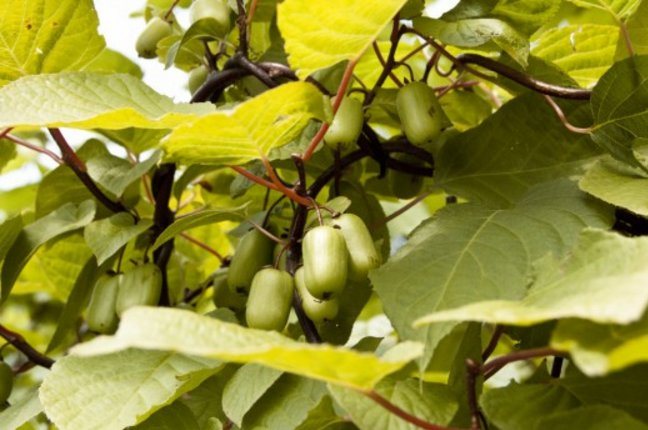

- argument and giralda - early September (acquire a bright green color and tender flesh);
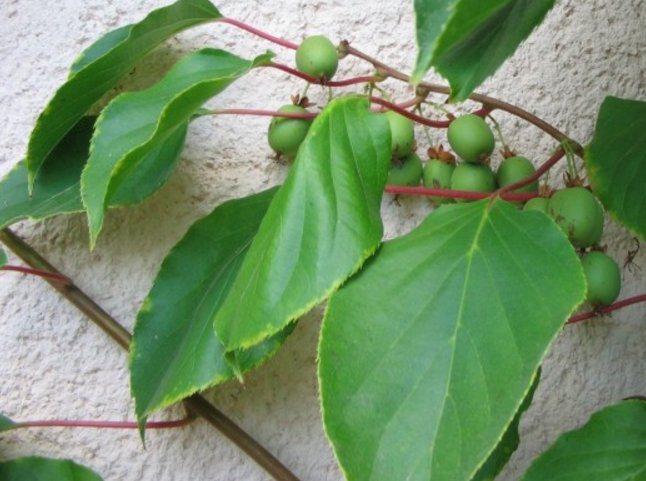

- polygamy - September (berry color - from yellow to orange);


- purple - end of September (berries do not crumble, purple in color).


Fresh fruits are best stored in cool rooms with good ventilation (they absorb odors strongly).
Did you know? One actinidia berry provides a person's need for vitamin C per day. Kolomikta berry contains 4 times more vitamin C than black currant and 13 times more than lemon. When processing actinidia berries, all vitamins and active substances are preserved. Pectin in actinidium berries actively removes salts of heavy metals and radioactive isotopes from the body.
Actinidia berries are stored:
- frozen (wash the berries, wipe and freeze);
- dried (wash and dry in the oven (55 degrees);
- like raw jam (grated berries with sugar - 2 to 3);
- dried (washed berries are poured with hot syrup, heated for 7 minutes, the syrup is drained, the berries are dried in the oven for 15 minutes at 80 degrees.
Chinese gooseberry or Far Eastern pineapple?
People have tasted the actinidia berries and tasted the notes of many fruits. An unusual plant with small shaggy fruits immediately appeared dozens of funny names that reflect different fruits-berries: Chinese gooseberries, hairy grapes, Amur raisins, green lemon, Far Eastern kiwi, pineapple on a tree and others. And, indeed, the actinidia fruits were like a bouquet of flavors with base, middle and top notes. They beckoned seriously and for a long time.
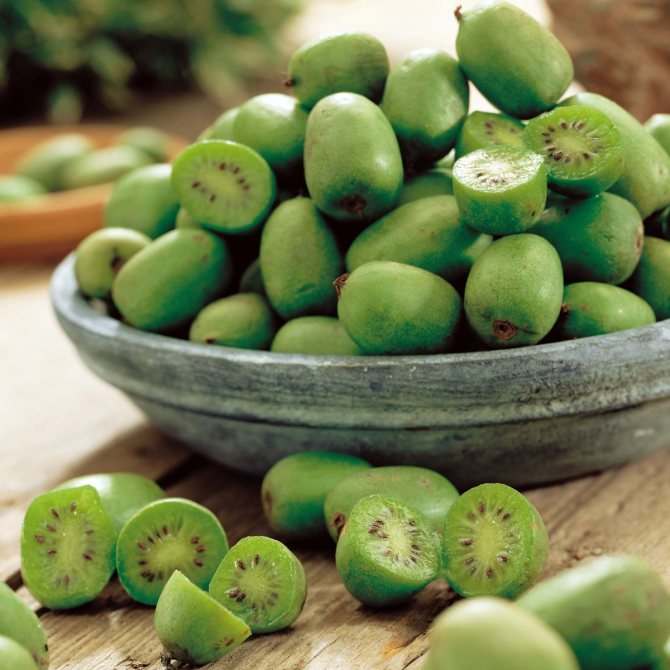

The small size actinidia fruits taste like various southern fruits
Actin breeding industry appeared in Russia. And the liana itself took an honorable place in gardens and parks, because it received fame, including due to its decorativeness. Let's get to know her better.
Actinidia is a tree-like liana, the natural growing conditions of which are Korea, China, Japan, Sakhalin, Kuriles, Primorye. Repeatedly wrapping around tree trunks, its tentacles climb high and far along them. The length of the whip is 35 meters - a fairly typical size for a wild plant. In cultivated varieties, the length is slightly more modest - 7-10 meters.
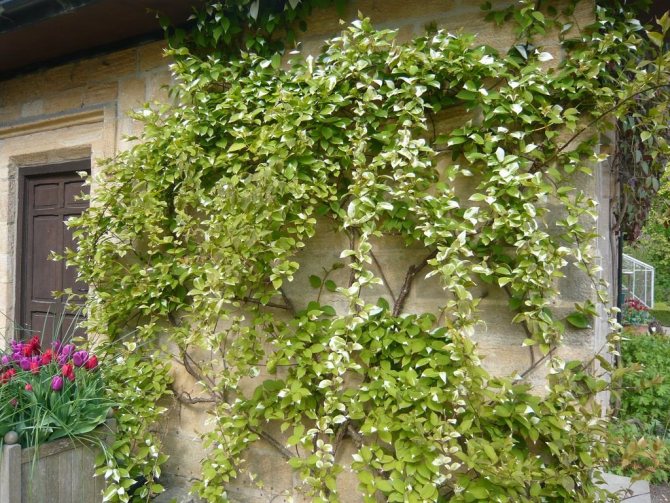

The scourge of the tree-like creeper of actinidia can go 35 meters or more in length.
The size of the fruit also varies: from a large 100 grams in the Kivaldi variety, bred at the Research Institute of Subtropical Crops in Sochi, to a small 3 grams, as, for example, in the Robinson variety, a product of the Vladivostok Experimental Station. The warmer the climate, the larger the fruit. But at the same time, the taste always remains a mystery, playing either with the aroma of apples or pineapples, or with a lemon sillage or nutmeg filling, or comparable to grape seeds or fig sweetness. In terms of the content of vitamins, in particular ascorbic acid, actinidia has no equal - in this regard, it is several times superior to lemon and black currant.
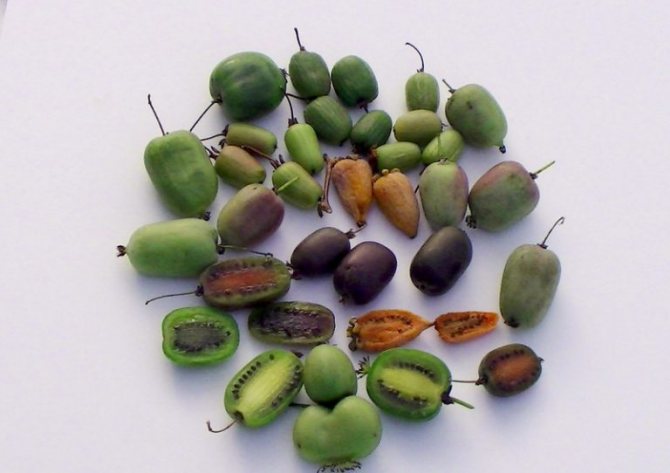

In the taste of the fruits of actinidia, you can catch apple, grape, fig, pineapple notes
A wild liana can bear fruit for up to 50 years, and live even longer. However, the garden liana does not differ in such longevity and, moreover, in fruiting. Its rejuvenation through the pruning method is recommended every 7-8 years.
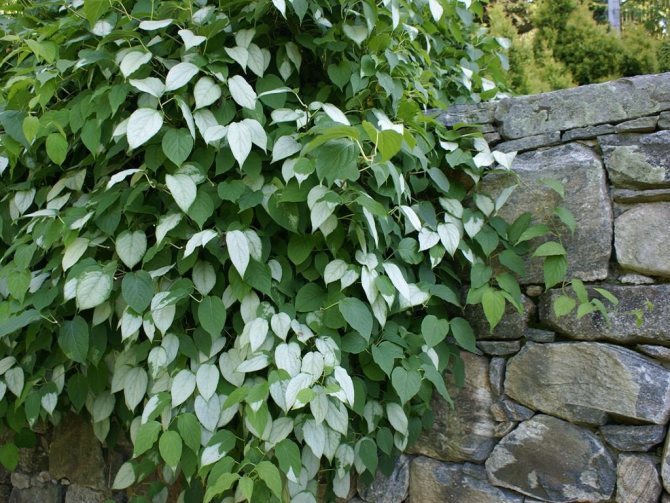

Actinidia liana has a long lifespan, but the decorative fruit will remain only if it is rejuvenated by pruning
How to propagate a culture at home
There are several breeding methods for growing actinidia:
- cuttings;
- arc layering;
- root suckers;
- seeds.


Saplings
For planting actinidia, you can use not only seeds, it is much easier to buy a ready-made varietal seedling. The main advantage of this breeding method is the rapid onset of fruiting. Seedlings grown from seed do not guarantee the preservation of varietal qualities, while seedlings retain all the properties of the species. Vegetative propagation simplifies the selection of plants by sex, so the floor of the seedlings obtained from cuttings is known before flowering.
Cuttings
Actinidia propagates by cuttings of two types:
- Green. In the summer, it is necessary to cut off shoots 0.5-1 m, divided into parts with 3 leaves on each. Root the cuttings in a sandy-humus mixture and cover with foil, watering and spraying as needed. In the spring before the start of the growing season, plants can be planted in a permanent place.
- Lignified. Cuttings should be prepared in the fall and stored vertically in sand at a temperature of about 3 ° C. In the spring, plant the twigs in a greenhouse and take care of them like green ones.
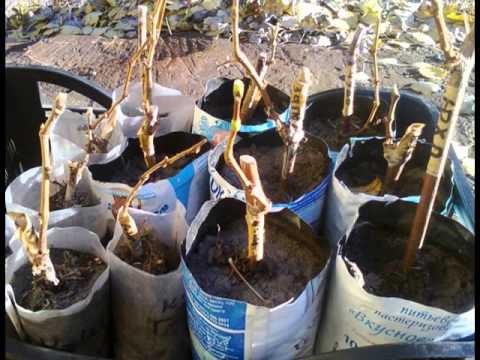

Landing in the ground
In order to plant kiwi, it is necessary to prepare the soil and suitable sized containers. At the beginning of March, each seed that has begun to open is buried 4-5 mm in damp ground. Further growth of actinidia depends on proper seedling care. A crop grown from seed begins to bear fruit late, 6-10 years after planting.
Required soil composition and container size
The container for planting actinidia should be spacious and deep enough. A suitable first container for vines should have a capacity of more than 12 liters. To grow actinidia in a pot, you need high-quality soil rich in nutrients. The acidity of the soil varies between 5.5-7 pH. You can make the mixture yourself by mixing the following ingredients:
- 4 liters of land from the garden;
- 4 liters of rotten needles or acidified peat;
- 2 liters of sand;
- 2 liters of herbal humus.


How many seedlings germinate
Actinidia takes a long time to germinate. Seeds begin to burst about 2-3 months after the start of stratification.
Placing containers in a warm place on a well-lit windowsill allows you to get friendly shoots 15 days after planting in the ground.
Seedlings grown from seeds, by the end of the first year, stretch by 2.5 cm. Next year, the sprouts will increase to 35 cm, and in another year - up to 1 m. At this age, the plants are ready for transplantation to a permanent place.
Culling and replanting germinated plants
For normal pollination of dioecious actinidia and obtaining fruits, it is necessary to plant vines of both sexes next to it. Excess seedlings are discarded by gender after the first flowering. For 7-10 female plants, 1-2 male plants are needed, otherwise normal pollination and high yields cannot be obtained.
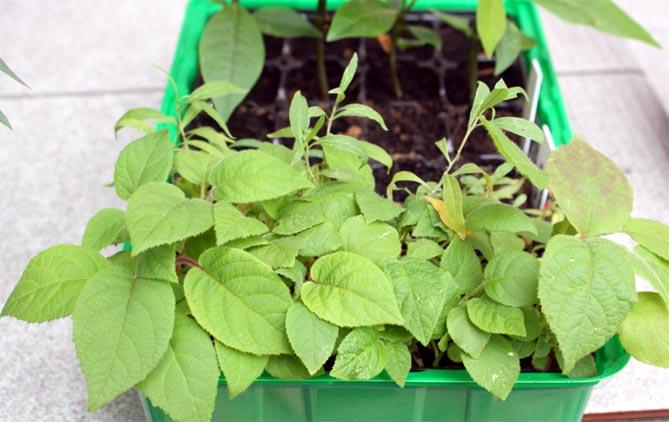

Seedlings selected for transplanting are planted in separate planting pits at a distance of 1.5-2 m from each other. The sequence of the procedure:
- Prepare holes with a diameter and depth of 0.6 m in 14 days.
- Lay out 10 cm of drainage at the bottom.
- Fill the pits halfway with a mixture of soil, humus, wood ash, superphosphate.
- Place actinidia in the hole and cover with soil, leaving the root collar above the surface.
- Water the plants.
- Mulch the root circle.
See also
Description and characteristics of the Black Prince apricot variety, planting and care
To read
Actinidia for the Leningrad Region and North-West Russia
For the Leningrad Region and similar climatic regions of the north-west of Russia, the best species for cultivation are colomict actinidia obtained by acclimatization of wild Far Eastern varieties. The Moscow Institute of Selection and Technology carried out a huge amount of work, the results of which in the period from 1995 to 2019 made it possible to present to the horticultural society a whole galaxy of excellent varieties of actinidia.
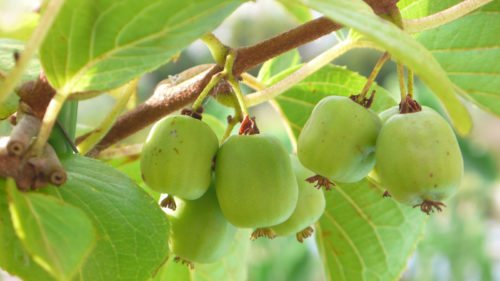

The Kolomikt species of actinidia is considered the best for the northwestern region of Russia.
Varieties for Southwest Russia
These are, first of all, kolomiktovye plants. Why exactly are they? Because it is the most resistant species to cold and frost. And even if in the northwest, frosts at -300C do not rage, but bad weather in the form of wet precipitation, piercing winds and constant fogs does not allow the productive cultivation of other types of actinidia. The top five for this climatic zone include the following varieties:
- Gourmet... Disease and pest resistant variety. It has a cylinder fruit with an average weight of 4–5 grams, with a delicate acidity, thin olive skin and pineapple aroma. Maintains an excellent balance of sugar and acid: 12.5% versus 1.4%. Received an expert assessment of 4.5 points. In the northwest region, it ripens in mid-August.
- Sugar... The name of the variety already reflects its whole essence. The taste has both sugar content and slight sourness. A characteristic feature of small fruits is the aroma of a strawberry meadow. Ready for harvest by the end of August.
- Fantasy gardens... The variety is a beautiful liana, on which small but tasty elongated fruits with a pineapple flavor ripen by mid-August. Their average weight is only 2.3 grams. The color is dark olive with characteristic light lobe stripes. Sugar and acidity are perfectly balanced in percentage terms: 14.5% and 1.3%. Score from tasters 4.5.
- Ella... The variety was named in honor of the famous actinidia breeder Ella Kolbasina, who began work on it, but did not manage to finish it. Ella has high winter hardiness and disease resistance. Fruits with a yellow-green color are small, the average weight is 3.5 grams. An excellent sourness is felt in the taste. Productivity is 50 kg from one hundred parts or 0.5 kg from one bush. Among the shortcomings of the variety, its strong crumbling is noted.
- Leningrad large-fruited... An excellent winter-hardy variety with high disease resistance. In appearance, the berries resemble green gooseberry varieties. Ripen in the second decade of August. Average weight 6 grams. Sugar taste with pineapple aroma.
Photo gallery: varieties of actinidia for the Leningrad region and northwest Russia
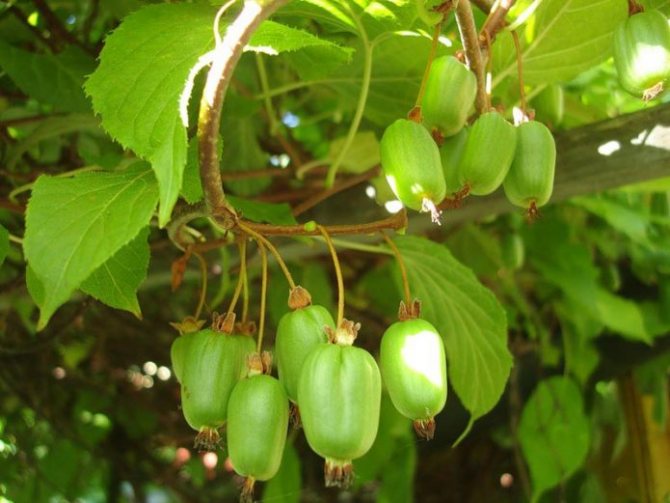

In the taste of Gourmet, there is a delicate sourness and aroma of pineapple
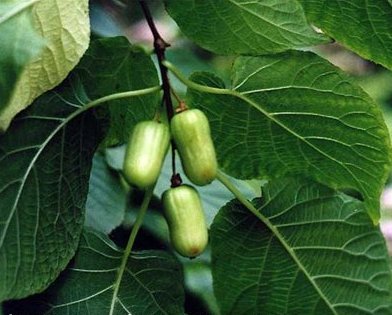

The elongated fruits of Fantasy gardens have an average weight of 2.3 grams Leningradskaya large-fruited - an excellent winter-hardy variety with high disease resistance
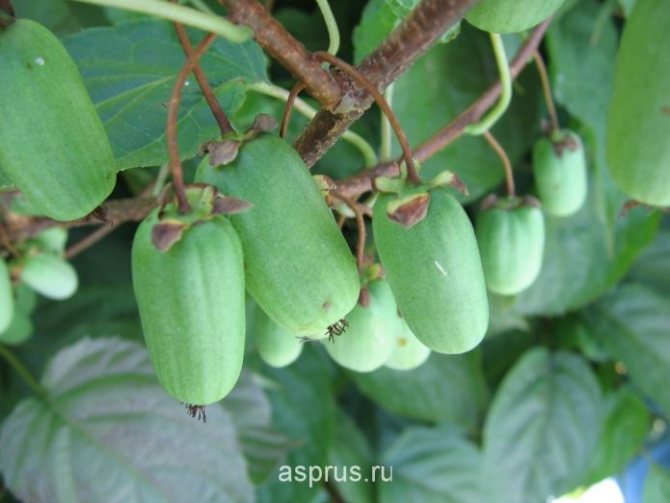

Household - a variety of early ripening with high winter hardiness
Features of growing actinidia in the northwestern region
There are no special rules for growing actinidia in the northwest region. The highlights are the same for all geographic areas. But, nevertheless, given the frequent dampness and coolness in this climatic zone, we can recommend some variations to the rules.
- Autumn planting of a young seedling in the ground should be carried out no later than the second half of September. The plant should have enough time to acclimatize outdoors.
- Autumn top dressing of vines after harvesting, it is better to carry out not through watering, but by scattering granular fertilizers under the bush, which will be absorbed into the soil along with rainwater, which often happens in the region. This form of mineralization will not create excessive moisture and prevent roots from getting wet.
- Actinidia in the Leningrad Region up to 3-4 years old should be sheltered for the winter. To do this, it is removed from the trellises, cut off and carefully laid on dry foliage. On top, lay another layer of leaves, spruce branches or peat. Synthetic materials are discouraged.
- At the roots of the laid plant, it will be correct to scatter poison for mice. Rodents do not like the taste of vine shoots, which have a peculiar sourness, but the arrangement of nests in their warm embraces is quite natural.
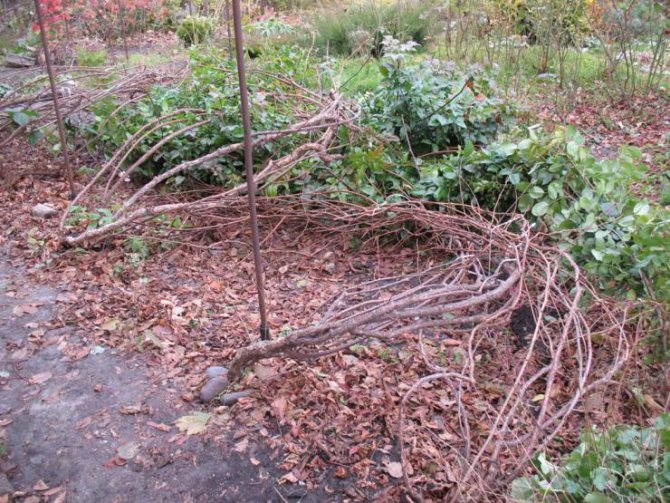

Liana in front of the shelter is removed from the supports and carefully bent to the ground
How to care for actinidia outdoors
Actinidia seedlings begin to bear fruit in the fifth year after planting. Shading is necessary for the active growth of a young plant.
An adult liana feels great under the rays of the sun. Moistened soil, fertilizer, and proper pruning are essential ingredients for healthy growth.
Watering and loosening
In the first year of life, vines are periodically shed from a sprinkler. The soil itself must be constantly moistened.


However, excess water will cause root rot. Mature bushes need watering only during dry periods. Once a week, a bucket of water is brought under the plant.
Only young plants need loosening, earthen crust and weeds inhibit their development. The culture has a superficial location of the roots: drought, intensive loosening can damage them.
The danger lies in the fact that the roots are not restored in the year of damage. In females, the root system grows faster.
Top dressing
Actinidia cannot be grown without fertilizer. To activate life processes, vines need organic substances.
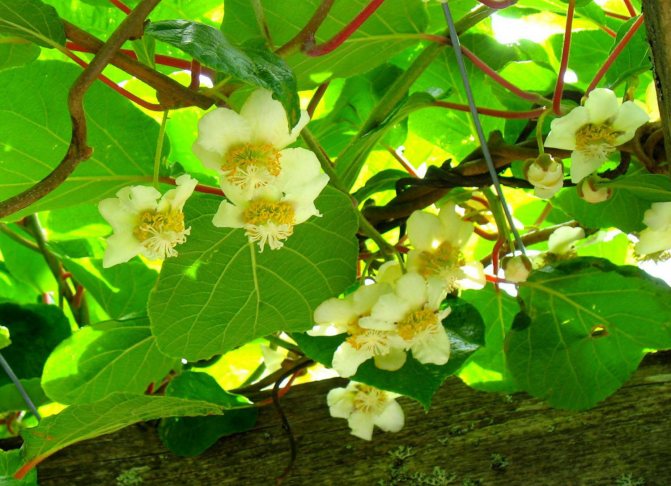

In early April, when the buds bloom, rotted manure is spread in a thin layer under the bushes.
Phosphorus-potassium fertilizers are applied twice a summer.
The first time the vine is fed during the budding period. After the fruit appears, the bushes are shed again.
Pruning
Actinidia pruning serves several purposes at once. It eliminates excessive crown density, activates the growth of new shoots, increases the yield and gives the bush the desired shape.
Pruning should not be carried out in March, otherwise the branches will “cry”.
It is convenient to form bushes during flowering.
The best option is to prune the actinidia in the fall. Dried, diseased and sagging branches are subject to removal.
Fruiting branches for several years are replaced with young shoots. Argut is thinned out more intensively than other species, since it bears fruit on shortened shoots. After the autumn pruning, actinidia is covered for the winter.
Wintering
The most widespread on the territory of Russia is the type of kolomikta. These plants do not need shelter. Moreover, vines wrapped up for the winter can resist.
Kolomikta is not removed from the trellises. The rest of the species are covered in the same way as grapes.
Before freezing, the branches are removed from the supports and wrapped in spunbond folded in two layers. With the onset of stable frosts, they are additionally covered with plastic wrap.
Useful properties of fruits
The more actinidia is watered, the better and faster it grows. She produces a lot of juicy fruits. These fruits are a source of natural vitamins.
Minikivi contains many useful substances:
- 100 grams of minikivi contains up to 1500 milligrams of vitamin C;
- minerals - potassium, calcium, manganese, lutein;
- Potassium (high in bananas)
- calcium (more than apples);
- a large amount of iron, magnesium.
Landing errors, care problems
| Problem | Explanation |
| When planting, not everyone takes into account the distance between the bushes. | It should be at least 1 meter, since growth slows down with thickening. |
| Many people buy seedlings from the market. | At such points of sale, it is more likely to buy vines without a varietal characteristic. |
| Root neglect, they are vulnerable. | It is forbidden to keep them in the air; it is better to use a closed container with earth. |
| Planted next to fruitful trees with strong roots. | Actinidia may die. |
Male and female actinidia
The culture is dioecious. On some individuals, she has only female flowers, while on others, only male flowers.
For the formation of fruits, it is required that pollen from the male plants get on the female ones.
Determining the sex of actinidia is easy, just look at the vine during the flowering period. Male flowers lack a pistil, but there are many stamens. The female flowers have a large pistil, while the stamens, on the contrary, are small.
These individuals are 95% sterile. Sex does not change throughout life.


Pollen from one plant to another is carried by beneficial insects and the wind. In autumn, male actinidia changes the color of the foliage from dark green to red.
Females do not have these properties.
On four female actinidia, one male of the same species must be planted.
To date, self-fertile actinidia has been bred.
However, its yield is significantly lower than dioecious lianas.
Productivity of actinidia
The yield of an adult vine depends on the variety and growing conditions. 5-10 kg of berries are harvested from one wild plant. Cultivated actinidia give a good harvest of tasty and healthy berries - up to 50 kg per diana with proper care. Some varieties, with intensive agricultural technology, yield up to 70 kg of berries from a tree.
In some varieties, the fruits ripen together, in others - gradually. In addition to different ripening periods, the fruits of certain varieties differ among themselves in weight, shape, color, flavor shades. Their chemical composition and main direction of use are also different.
Actinidia berries are consumed raw, jam and compotes are cooked from them, they are sprinkled with sugar and stored until spring. Homemade wine is made from fallen fruits.
Diseases
The analogue of kiwi is almost not affected by diseases, but some problems still exist.
| Disease | Description |
| Phylostictosis | The appearance of black spots, bordered with purple, which eventually turn into holes. The plant has pink mold. Such sheet plates are cut off and thrown into the fire, the rest are treated with Bordeaux liquid. To prevent the spread of the disease, fallen leaves are removed under the bushes. |
| Ramulariasis (white spot) | Leaves have white spots bordered with black. The lesions are burned so that the fungal disease does not spread. |
| Powdery mildew | Appears during severe waterlogging, if the shoots are poorly illuminated by the sun and are not ventilated. Milk bloom on the leaves can destroy actinidia. |
| Late blight | It affects the whole plant, a liquid is released on the root collar, the leaves fall off, the bark cracks. The main cause of the disease is over-watering. They carry out preventive measures, in case of a disease they are treated with copper sulfate. |
| Gray rot | On the leaf plates, brown spots are covered with a gray bloom. Actinidia is treated with fungicidal preparations, for example Fundazol or Topaz. |
Ascochitis of leaves | Dark brown spots on the leaves increase in size, gradually affecting the entire plant. Fungicide treatment. |
| Leaf spot | A huge number of black dots appear. Spraying with copper sulfate. |
Note!
When disinfecting a plant, it is necessary to observe the quantitative content of the active ingredients of the preparations, since an overdose of actinidium can die.
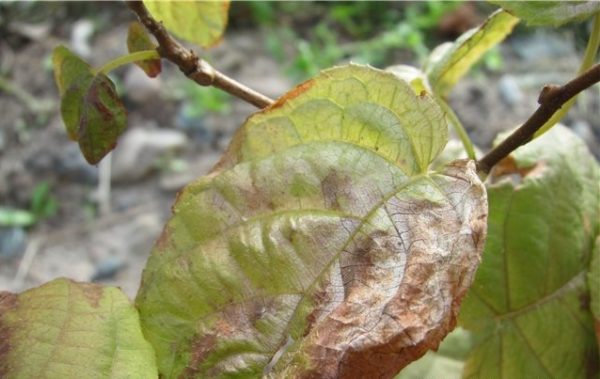

To prevent infection of the vine with fungal diseases, it is necessary to add copper-containing preparations in the spring.
The harvest
The nuances of fruiting are as follows:
- If you take proper care of the plant, the first fruits will appear in 4 years.
- At 7 years old, the peak of fruiting begins.
- Fruit ripening time is about two months.
- Many medicinal substances are preserved after processing.
- With good care, the actinidia bush is capable of producing 50 kg of harvest.
Ripe fruits are sour-sweetish. The cut fruit looks like a kiwi. Ripens gradually. Store in a cool place for no more than 1 day. Harvest every year, and its period depends on the species and variety.
Growing from seeds
Fresh seeds should be used for seed propagation. You can buy them in the store or get them yourself from a ripe fruit. The pulp is kneaded through cheesecloth, then the seeds are washed and dried in a cool shaded place. Preparation is necessary before sowing. First, the seeds are soaked in warm water for 4 days. The water is changed daily. Then they are placed in a stocking and immersed in wet sand with a temperature of + 18 ... + 20 ° C for 3 weeks. The stocking is removed and washed weekly. In early January, a container with sand and seeds is buried in a snowdrift or refrigerated for 2 months. Continue weekly to remove and rinse the seeds in the stocking.
After such a long preparation, the seeds are sown in boxes with a mixture of turf and sand to a depth of 0.5 cm. Already during planting, some seeds will hatch. Seedlings will appear within a few days. They are kept at room temperature and in bright, diffused light. It is important to spray daily and water the crops regularly. In summer, plants with 3-4 leaves are transplanted into a greenhouse, where they are grown for several years before flowering. When the sex of the seedlings is determined, they can be planted in the garden in a permanent place.


Diseases and pests: control and prevention
The plant grown in the garden is not subject to disease. But still there is a possibility of the following diseases:
- Phylostictosis of leaves;
- Leaf ramulariasis;
- Powdery mildew.
In order for the plant to always be healthy, preventive measures should be taken that will prevent diseases. First of all, it's the purity of the plant. For this, dry leaves are removed, and healthy ones are washed with soapy water. Spraying with garlic solutions, tobacco infusion or cyclamen solution is carried out. Pharmaceutical tincture of calendula is also suitable for processing.
Actinidia will delight its owners with a good harvest, if properly cared for. This applies not only to this plant. However, in order for the garden to be like in a fairy tale, it must be looked after with love.
The dioeciousness principle
It is important to take into account that actinidia is a dioecious plant. This means that pollination in the flowers of one specimen does not happen by itself. To form an ovary, two plants are required: one with male flowers, the other with female flowers. Pollen from the male inflorescence is carried by the wind, bumblebees and bees.
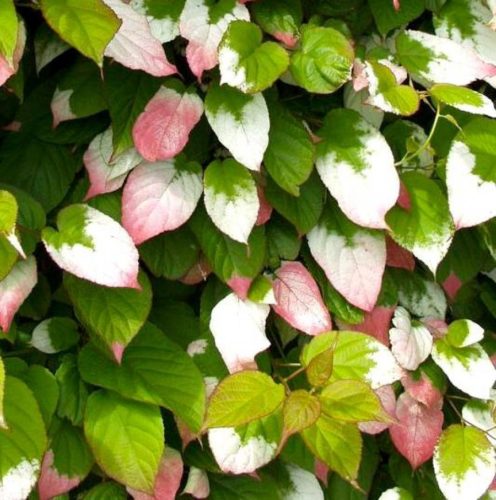

The male plant does not bear fruit, but without his work as a pollinator, the crop on female plants is impossible.
Some varieties sometimes have bisexual flowers, but pollination with their own pollen is weak and unproductive.Therefore, regardless of the variety of actinidia, it is recommended to plant one pollinator bush with male flowers on a plantation of 7–8 female bushes. These can be both ordinary varieties and universal ones designed specifically for pollination.
- For argut crops: Sunny, September, Emerald;
- For kolomikt cultures: Commander and Adam;
- For actinidia Giralda: Emerald.
- For actinidi polygamy: Brunet.
Moreover, it should be remembered that argut female bushes cannot pollinate a kolomictovy bush, even if it is masculine. And the kolomictovaya vine does not lend itself to pollination by an argut pollinator.
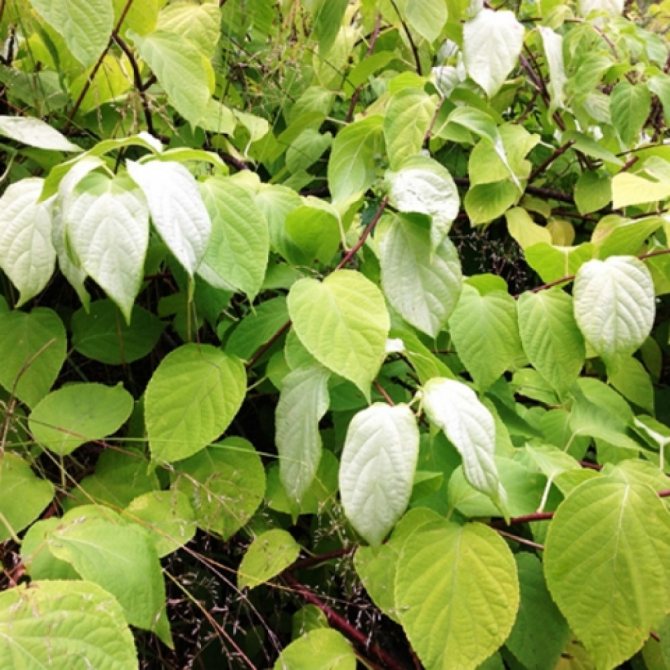

The brunette is considered a pollinator for polygamous actinidia
There are self-pollinated varieties, but there are not so many of them. One of the typical representatives is the Japanese argument Issei. Gardeners note that even a female plant of this variety, without the participation of male flowers, can produce an excellent harvest of sweet berries. And, although their size is not large, the pleasant taste and medium-late ripening of small kiwi in September will truly delight lovers of exoticism. The list of Issei's advantages is complemented by the compactness of the bush, cold resistance up to -25 25C, the ability to grow rapidly and bear fruit even by the end of the first year of life.


Issei is declared as a self-pollinated variety of actinidia
By the timing of ripening, actinidia is classified into early varieties (August), medium early (late August - early September), medium late (late September) and late (October).
The best varieties and varieties
Many interesting varieties of actinidia have been bred. They are all divided into male and female. When purchasing a seedling, it is important to know its characteristics and type of flowering.
This male form fits all female varieties. A curly decorative liana grows up to 3.95 meters in height, the plant needs support. At 3-4 years of age, greenish leaves turn white at the end of May, and turn pinkish in summer. The older the crop and the more it gets a sunny color, the more often the leaves are colored. Flowers are collected in inflorescences-shields, 3 pieces in each, do not form fruit. Liana is used to decorate arches, walls, arbors.
September
Female grade. A pollinator is required for fruit development. Liana grows to a height of 3.95 meters, she needs support. Greenish leaves change color, turn white, and after flowering - crimson. The fruits are yellowish-green, outwardly reminiscent of gooseberry berries. Ripen at the end of summer.
The berries have a sweet and sour taste, reminiscent of pineapple and apple. Ripe fruits fall off on their own. Fruiting begins at 3 years of age and lasts 30 years.
Self-fertile actinidia, or polygamy


This actinidia is self-fertile. One of the rare self-pollinated species.
A special feature is the bright orange color of ripe fruits. This is due to the high content of carotene, which makes this species of actinidia a worthy competitor to sea buckthorn.
It should be noted that self-fertile actinidia is distinguished by the unusual taste of the fruit. They combine the flavors of paprika and figs and are very sweet when fully ripe. Unripe fruit has a slightly pungent aftertaste. Some varieties have a highly developed pungent taste. The shape of the fruit is oblong, with a sharp tip. Berries are used to make sauces, and salads are prepared from young shoots. All varieties of actinidia polygamy begin to bear fruit already from the third year of life, are distinguished by high productivity and long life expectancy.
Preparing for winter
It is necessary to prepare actinidia in the suburbs for the winter. We do the following:
- We remove from the support.
- We put poison against rodents under it.
- Sprinkle with fallen leaves and peat.
- Cover with foil.
They are sheltered as soon as the constant cold begins, usually at the end of October. You can shoot the film in April, but only at positive temperatures.
In September, sanitary pruning is done and after picking the berries, the last portion of fertilizer is applied.
Fruiting and picking berries
The first fruits of actinidia can be harvested 3-6 years after planting, the ripening period is from late August to late autumn. An adult plant produces 12-60 kg of fruit annually. To harvest correctly, you need to shake off the fruits on the canvas from a low height. To do this, it is enough to shake the liana a little, the greenish ripe berries will quickly fall off, the immature ones will remain in place.
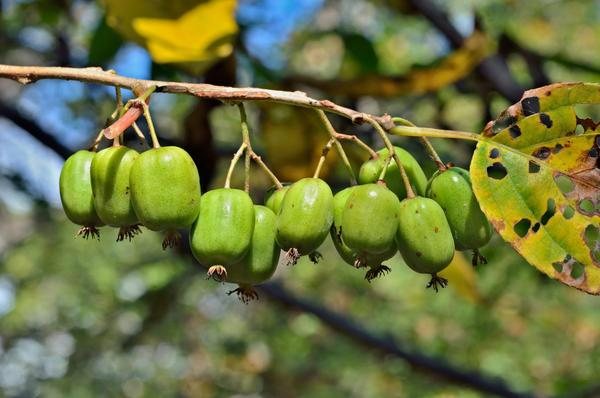

Planting a plant
Actinidia can be planted either in early spring, before sap flow begins, or in autumn, at least 15 days before the start of frost. The recommended distance between plants is 1.5-2 meters. If it is supposed to plant along the wall, then it can be reduced to 50 cm. For every 3 female plants, you must certainly plant one male, otherwise the actinidia will not bear fruit.
It is recommended to prepare planting holes 15 days before planting. Their depth should be half a meter. Drainage is placed at the bottom of each hole, then peat with a mineral mixture consisting of 120 g of ammonium nitrate, 250 g of superphosphate and a handful of ash. On the day of planting, when the soil settles, the fertilizer is covered with soil. The plant is planted on it in such a way that the root collar is located at the upper level of the soil. The roots are straightened and covered with earth until the hole completely disappears.
Then abundant watering and mulching of the soil is carried out. It is advisable to protect the young plant from cats that like its smell. For this, a special fence is made. They also shelter the plantings from the bright sun so that the seedlings take root faster.
Landing actinidia
Features of the
Priming. It should be fertile, but with minimal clay content. Actinidia literally does not tolerate limestone.
Planting in places where groundwater comes close enough to the surface is not recommended.
The best place is on a hill. If there is a risk of flooding the territory with melt, rain or groundwater, it is necessary to take care of effective drainage.
Landing is done, as a rule, along fences, around the perimeter of arbors, and the like. One of the main conditions for the good development of actinidia is that it needs a solid support. As an option - a frame structure, which is located on any part of the territory to transform the landscape.
It is not worth planting a plant near shrubs or trees. A struggle will begin between them for "natural resources" - moisture, nutrients, light - and as a result, someone will be the loser with all the consequences.
The best time to plant actinidia is early spring, after the soil has warmed up. The best age for shoots intended for planting is 2 to 3 years. It is believed that such sprouts take root very quickly. But the older ones tolerate the procedure much more difficult.


Procedure
- The shoot is deepened to the root collar, after which the hole is covered with a mixture of earth and sand.
- Drainage arrangement. At the bottom of the pits, brick breakage, pebbles with coarse sand are poured, after which the layer is compacted. It is forbidden to use crushed stone (it contains lime!).
- Before planting the vines, a line is traced. The minimum distance between the holes (the optimal depth and diameter of which is about 50 cm) is 2 m.If the shoots are placed closer, then after a while the sprouts will begin to interfere with each other elementarily, and a struggle for survival will begin between them.
- Above - a little fertile soil, and then - a mixture of organic components. Wood ash (or potassium sulfide) - 40; ammonium nitrate - 150; superphosphate - 300 (g).
- Then watering is done, and abundant. For 1 plant - at least 30 liters of water (3 buckets).


Care
- Alkaline, acidic or slightly acidic media are preferred. In accordance with this, fertilizers are selected. For example, potassium chloride.
- Irrigation is the same as for all plantings. Mostly moderate. The expediency of watering is judged by the state of the soil at the roots.
- Care must be taken that they are not exposed, otherwise thermal burns cannot be avoided. If this is found, then immediately sprinkle the roots with earth.
- Actinidia loves moisturizing foliage. If it is not possible to install a sprinkler next to it, then it is recommended to periodically practice spraying.


- Mulching must be done at the beginning of autumn. This will allow you to retain moisture at the roots for a longer time and insulate them somewhat.
- You cannot dig up the ground, otherwise the root system may be damaged - only loosening.
- If the weather is sunny, plus temperatures are high enough, then in order to avoid burning young plants, it is advisable to cover them with a canvas that allows air to pass through well (so as not to create a greenhouse effect).
- For the winter, the root system is additionally insulated. What to use? As options - humus, spruce branches, needles, sawdust.
Soil and place for actinidia
But it is not enough to find planting material, you need to be sure that the soil on your site is suitable for growing this exotic plant. Actinidia grow well on chernozems, sandy loam, taiga, forest and other lands that have a loose structure, allow air to flow to the roots and do not retain water near them. On heavy, clayey soil, the vines, if they do not die, will not develop and bloom. With a great desire to grow actinidia, even on clay soil, you will have to dig a large hole, the dimensions of which correspond to the size of the roots of an adult actinidia. Then fill it with loose and fertile soil.
Actinidia with age form a powerful root system, but most of it is located at the surface
The root of the kolomikta is pivotal, extending 120 cm deep. Many thin adventitious roots grow on it, forming a fibrous system. Most of it is located near the surface, at a depth of 0–40 cm, extends within a radius of 60–80 cm from the trunk, and occupies an area of 1.1–2.0 m². Arguta is a more vigorous plant, the length of the central root is about 4 m, the bulk of the feeding roots are located at a depth of 1–2 m, for one liana, a space of 2–5 m² is required.
Acidity is important for actinidia, a weakly acidic environment is needed for good development, it is impossible to lime the earth.
Knowing which piece of land your actinidia will occupy in the future, and given that you need to plant at least 2-3 seedlings (male and female), you can start choosing a place. Conditions on it should be close to natural. Plants live in taiga and deciduous forests, twine their stems around tree trunks, which means they love moisture and sunlight scattered through the foliage.
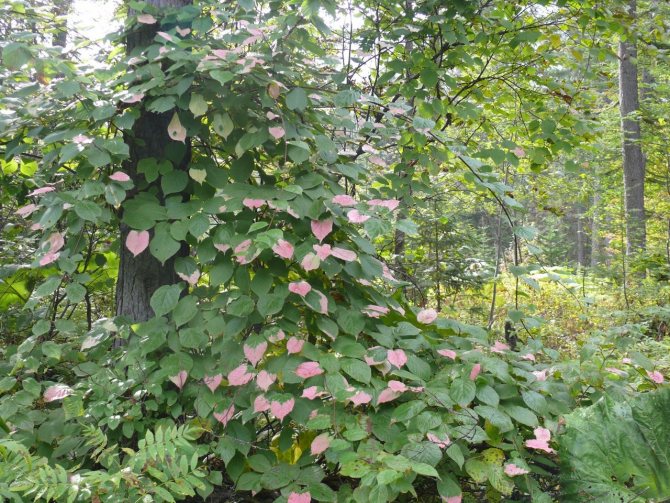

Wild actinidia grow in the forest, they do not like direct sunlight
However, do not rush to place seedlings next to garden trees, since cultivated apple and pear trees are not as powerful as taiga cedars. Actinidia is an aggressively growing liana, it quickly captures the adjacent territory, braiding everything around with thick and woody shoots. As a result, adult actinidia can win the competition for food and a place in the sun of all its neighbors.
Video: kolomikta planted on the eastern side of the building (Novosibirsk)
The culture loves to grow in the shade, but the fruit sets and ripens in the sun. In a shady place, the stems are pulled out towards the light, and the fruits are tied only at the tops. Experts advise placing the vines so that they are well lit by the morning sun and protected from the scorching rays during the day.
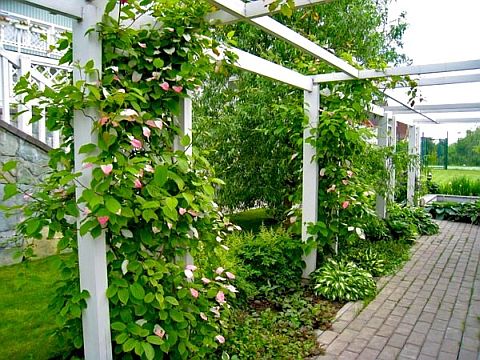

For actinidia, strong supports are needed, it is better to place them on the east side of the house
The site on the east side of the fence or building is quite suitable. But here you need to take into account the height of the vines. Thus, a whip of argut reaches 7-15 m in length, and in the wild - up to 30 m, kolomikty is slightly lower. Having reached the height of the fence, they will begin to hang down and creep behind it. Those planted near the house will climb onto the roof. It is inconvenient to look after such thickets.Therefore, for actinidia, strong and high trellises are needed. In the northern regions, even frost-resistant kolomikts will have to be laid on the ground together with trellises or removed from them. This means that there should still be enough space next to the plantings of actinidia for their shelter for the winter.
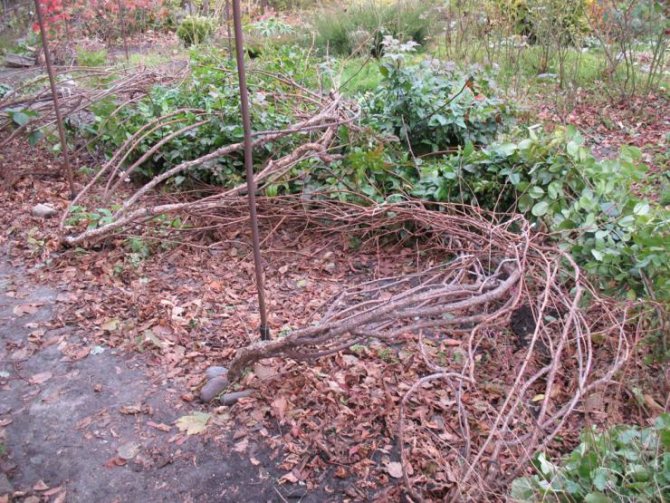

In autumn, in regions with frosty and snowy winters, vines are laid on the ground, and snow will serve as a shelter
Actinidia argut


Actinidia arguta is a strong vine, 18-25 meters high and very thick at the base. The bark of the stem is light gray. Leaves are green, monochromatic. Flowers are odorless, larger than that of actinidia kolomikta, with a greenish tinge. The fruits are larger, on average up to 7 grams, with a delicate pulp of sweet and sour taste. The variety is fruitful, but does not tolerate frost well.
On the basis of actinidia arguta, several large-fruited frost-resistant varieties have been bred. They have bright fruity aromas, ripen together and do not crumble. Arguta varieties with a pungent taste are very interesting.
Varieties of actinidia arguta type:
- Firebird - The fruits have a hot pepper taste and a peppery smell. The size of the berries is up to 6 grams. Late maturing.
- The spindle is a late-ripening variety. Fruits weighing up to 6.5 grams, sweet-peppery taste with fig aroma.
- Healing - the name was given to the variety for the high content of carotene in the fruits. The fruit weighs on average 4-4.5 grams. Fig and sweet pepper flavor. Late ripening variety.
When to plant actinidia
Planting dates depend on the growing region. So, in the south, spring is dry and warm, quickly giving way to hot summer, so it is better to plant here in autumn, in September - October. In the middle lane, in the north and in Siberia, autumn is not constant. Rainy weather sometimes lasts until November, but more often frosts begin to shackle the ground in September. Therefore, it is better to plant young actinidia in spring, in April - May. If you are lucky enough to buy seedlings with a closed root system, usually cuttings rooted in containers, then you can plant it even in summer.
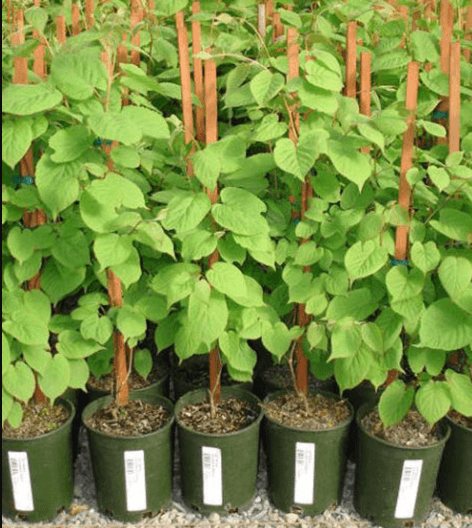

Actinidia seedlings in containers can be transplanted from spring to autumn
When planting in spring, plants should not be pinched or trimmed. Damaged vines cry a lot before the leaves bloom and can dry out completely. Do an autumn planting about a month before the onset of frost on the soil. For seedlings with an open root system, the absence of leaves is desirable, that is, in the spring they have not yet blossomed, and in the fall they have already crumbled.
Video: summer planting of an actinidia seedling with a closed root system (Ukraine)
Medicinal properties and contraindications
Actinidia has tremendous benefits. Its berries contain a large amount of ascorbic acid, fatty oils, micro- and macroelements. Using them, you can heal the body and strengthen the immune system. Fragrant berries relieve whooping cough, scurvy, anemia, bronchitis, tuberculosis, rheumatism, constipation, dizziness, hypertension and fever.
The fruits are eaten fresh and made with jams, preserves, jelly, compotes, marmalade. Bark, leaves and flowers also have beneficial properties. Decoctions and oils are prepared from them for internal use, wrapping and therapeutic massage.
Due to the large amount of active substances, actinidia is contraindicated for people prone to allergic reactions, suffering from thrombophlebitis, varicose veins, and high blood clotting.
Testimonials
Reviews of gardeners show whether it is possible to grow actinidia in the Moscow region:
This year the bushes have grown to 1 meter. On one liana there are 3 berries, on the other 4, the leaves are green-crimson.
Sveta
They bloom and bear fruit every year, as they mature, the amount of the crop increases. There are no problems with leaving.
Vera
There were many plants, but gave away all but one, they are female. It is constantly attacked by spider mites. I tried to propagate the plant by cuttings, it did not work, it did not want to take root.
Alexander
You often have to prune, because with abundant watering and good weather, actinidia can grow up to 3 meters. When it takes root, we plant it with a deepening of the place, but we do not fall asleep until autumn.
Pavel
Actinidia of the Kolomikta variety is a deciduous liana, which is not at all afraid of Siberian frosts. This culture appeared relatively recently in the gardens of summer residents. Actinidia berries taste like kiwi, but only 3 centimeters in size. The culture bears fruit in the presence of male and female shrubs in the same garden area. Fruiting begins already at the 3rd year of the vine's life, and lasts 30 years.
Further care
After planting, actinidia must be properly cared for. Liana must definitely prepare a reliable support, young shoots need an indication of the direction of growth and tying. In addition, the plant grows vigorously under suitable environmental conditions.


Temperature and humidity
Actinidia belongs to deciduous crops, therefore, if, depending on the season, the temperature regime for growing is different, the culture drops foliage and goes into a dormant stage. The same effect occurs due to insufficient moisture.
In winter, 7-10 ° C is enough for the plant; in warm rooms and greenhouses, foliage on vines is preserved.
The normal vegetation of the plant continues at 20 ° C. At rest, some species of actinidia are able to withstand frosts down to -45 ° C.
Illumination of the place and ventilation
For growing actinidia, areas that are well lit by the sun or in the shade are suitable. It is ideal to combine bright light in the morning and partial shade in the afternoon. The place must be protected from strong winds and drafts.
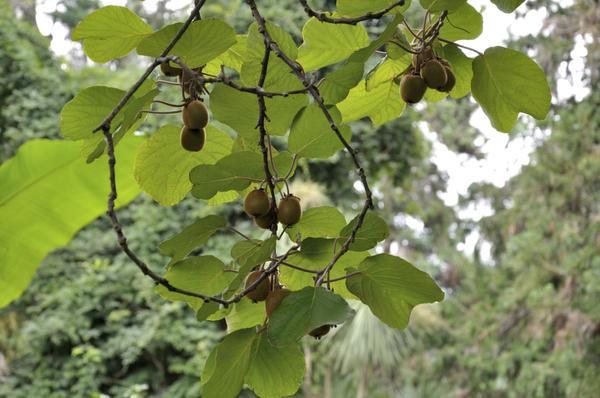

Watering and feeding
Actinidia prefers moist soil, so you need to water the plant as the soil dries up. In the dry season, watering is carried out every 4 days at the rate of 80 liters of water for each plant.
It is enough to apply fertilizers to the soil during watering several times a season:
- in early spring, nitrogen fertilization is sufficient;
- at the beginning of fruit formation, potassium-phosphorus mixtures with a small amount of nitrogen can be added;
- after harvesting, potassium and phosphorus are enough.
Bush formation
The formation of the crown of actinidia begins after 3 years of growing vines. The plant must be cut according to the following scheme:
- At the very beginning of spring, it is necessary to thin out the shoots in order to avoid thickening of the crown.
- In summer, the twigs can be pinched to reduce the growth rate of the vine.
- In autumn, plants over 10 years old are rejuvenated. Shoots are shortened to 25 cm.
- Winter is the time for sanitary pruning. It is necessary to remove overlapping branches, thickened, growing downward.
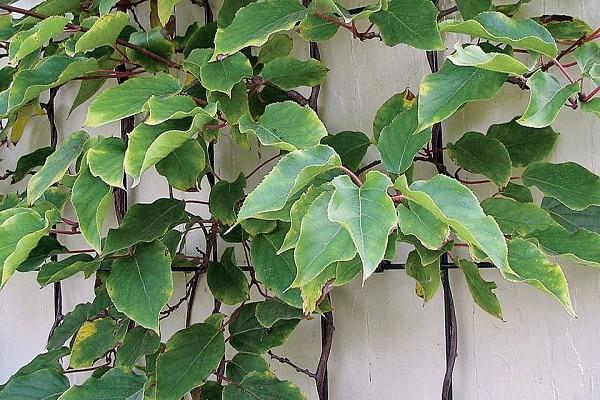

Transfer
It is necessary to transplant an adult plant to a new place in spring or autumn, so as not to carry out the procedure during the period of juice movement. In advance, you need to install supports for actinidia and prepare the landing pits. Dig the vine out of the ground carefully so as not to damage the superficial root system.
Diseases and pests
Dangerous diseases of actinidia are:
- spotting;
- fruit rot;
- powdery mildew.
Prevention and treatment of fungal infections involve spraying with a solution of Bordeaux liquid, soda, or chemical fungicides.
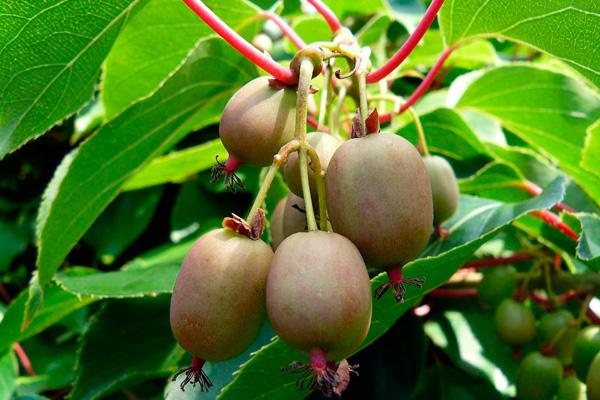

Outdoor cultivation makes actinidia an object of interest for insect pests:
- bark beetle;
- moth;
- lacewing;
- leaf beetle.
The plant can be protected by spraying in the spring and fall with chemical insecticides or copper-based preparations.
Actinidia for central Russia
The "middle zone" refers not only to the Moscow region, but also to the nearby regions, the Upper and Middle Volga regions, as well as lands to the west of Moscow. This group of actinidia includes plants of the cold-resistant type, which have the so-called "1 point" for frost resistance. This means that the climate in the region of their growth should be with mild, non-aggressive winters and temperatures not lower than -200C.And in order for a winter sleep to be comfortable, you need to take care of the reliable wrapping of the plant. Lapnik, peat, sawdust, needles will perfectly warm the plant. Burying vines deep into the ground or a shelter made of polymeric materials for actinidia is not practiced.
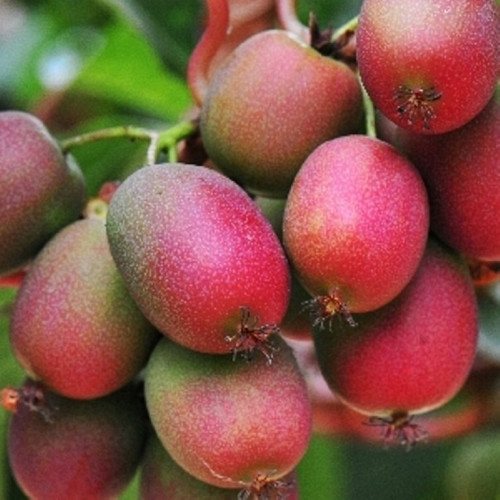

The fruit of the Pineapple variety has practically no core and seeds
Of the varieties cultivated for this climatic zone, many kolomikt and argut varieties are quite suitable: Pineapple, Primorskaya, Dalnevostochnaya, Izobilnaya, Dachnaya, Vinogradnaya, Universitetskaya, Samarchanka, Soroka, Slastena, Doctor Shimanovsky and others.
Photo gallery: Actinidia for central Russia
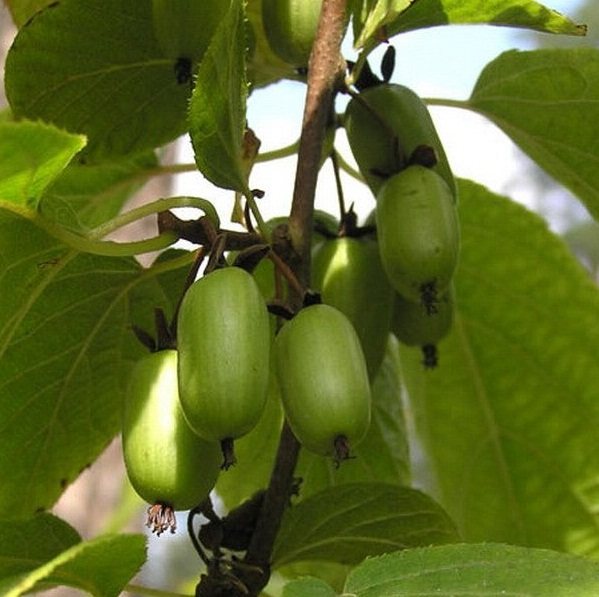

Fruit of Izobilnaya variety has a shape slightly compressed on the sides and weighs 3–6 g
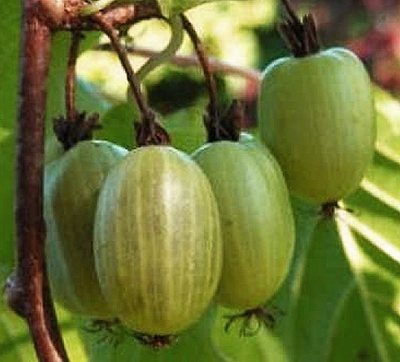

The fruits of the University have a sweet-tart taste with a strawberry aroma.
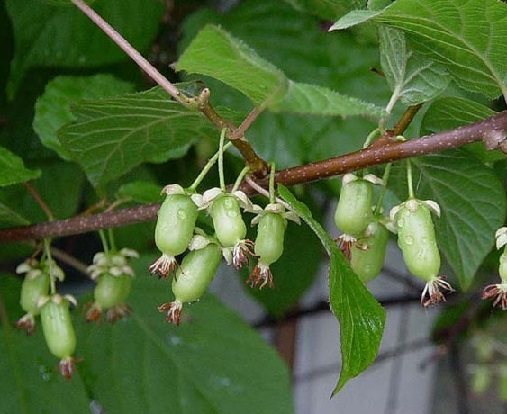

Notes of apple marmalade with a slight sourness distinguish the Grape variety from any other variety.
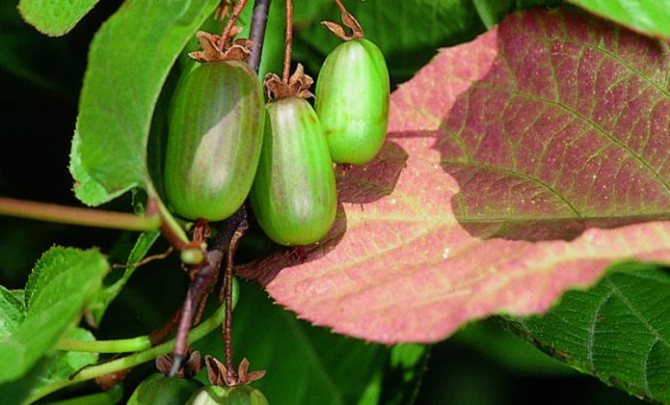

The disadvantage of Dr. Shimanovsky is the crumbling of the berries as they ripen.
All of these cultures are good and seductive in their own way. But the most exotic, some gardeners recognize the polygamous actinidia Apricot for its sweet pepper flavor in fruits. At the same time, the sugar content is quite high - 14.2% against the background of 0.5% acid.


The sugar content in the fruits of Apricot is quite high - 14.2% against the background of 0.5% acid

